May 1 - 7, 2022: Issue 536
Ray Henman ACS
Avalon Beach octogenarian Ray Henman ACS, a cinematographer, has an over 70 years connection to Pittwater. Growing up at Palm Beach he saw the village become a weekenders paradise while working at his father's garage. Travelling to Manly Boys High School with fellow Palm Beachers was part of his childhood.
It was his passion was for film though that would one day lead to working at Channel 9 and then at the BBC with David Attenborough and an Emmy nomination from The National Academy of Television Arts and Sciences (Hallmark Hall of Fame) 1971 for 'Snow Goose'. Ray also filmed Her Majesty Queen Elizabeth's Christmas Addresses when working in the U.K. and travelled as a film man as part of Royal Tours. Both Sir Attenborough and Her Majesty are celebrating their 96th birthdays in 2022.
Ray's other passions are classic automobiles and local history.
This week a small insight into a long and still ongoing career in film and television from one of our local legends.
When and where were you born?
I was born on the 15th of May 1939 in room 9, St Lukes Hospital, Potts Point.
Where did you grow up?
Up until the age of 10 I lived at Seaforth. My dad, William John Henman,(Jack) was always in the Service Station business apart for two years during WW2 when he was at MILNE BAY New Guinea repairing Fairmile Cruisers for the US small boats contingent.
On return, he first had garages on the South side in Bondi and Coogee before moving to Seaforth, where he ran the Independent station now the Seven-Eleven garage in Spit Junction. I remember that location very well. He had a big till in the office with a poker machine right next to it !
In 1948, he moved to the Peninsular and with his business partner, Jack Rigney, and took over the Shell Palm Beach Garage, which was located on the northern corner of Iluka and Barrenjoey Road. In those days I spent a lot of time serving petrol, these were the days garages offered full driveway service not chocolate factories ! My interest in the 40’s & 50’s cars was kindled then which led to a small collection of preferred models later in life. I currently retain a 1952 Studebaker Starlight Coupe and two twin cylinder Citroen 2CV’s, (influenced by a certain Parisian gal back in the 60’s).
My first car was a 1924 Buick. My father denied me a motor bike which made me grateful when Tommy Gilbert came to grief on one.
On the opposite corner north of the Garage was the Port Jackson and Manly Steamship Company’s general store. The wharf was down from there which was run by Chick Witchard.
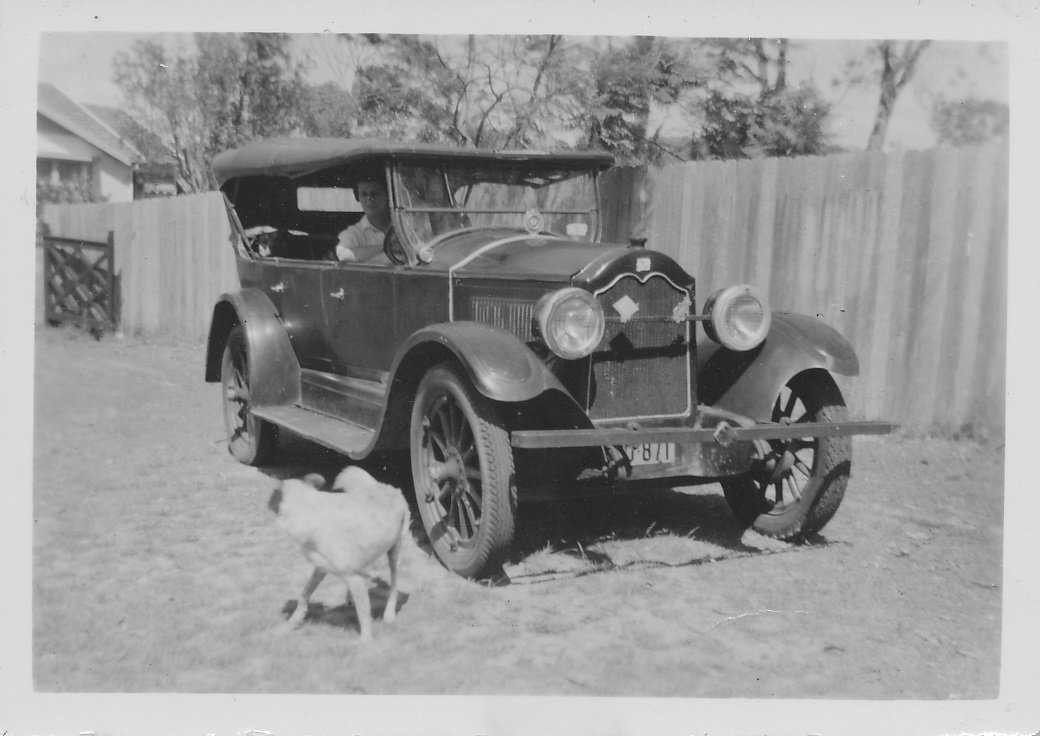
Ray's 1924 Buick
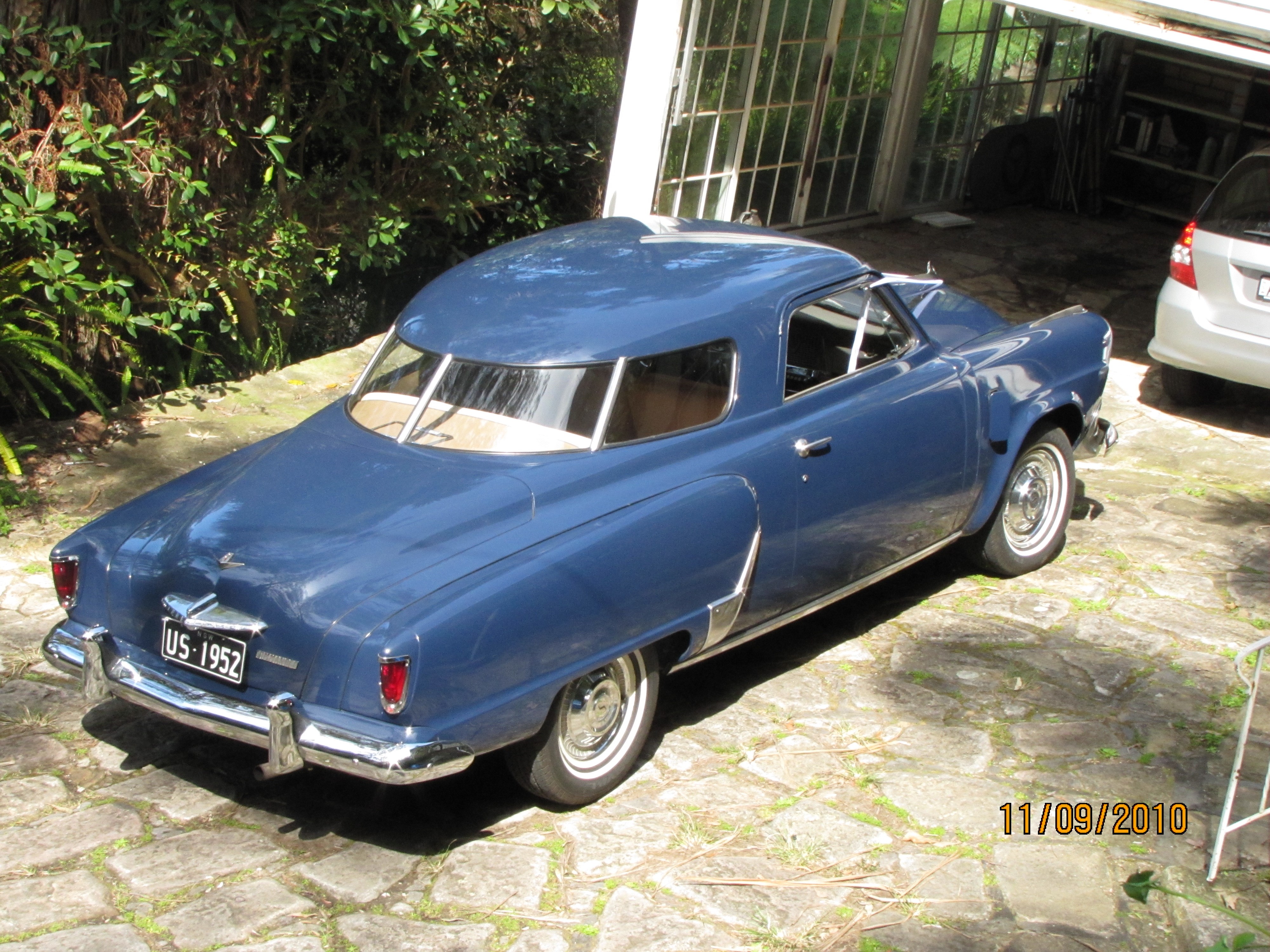
Ray's 1952 Studebaker Starlight Coupe

Ray's twin cylinder Citroen 2CV
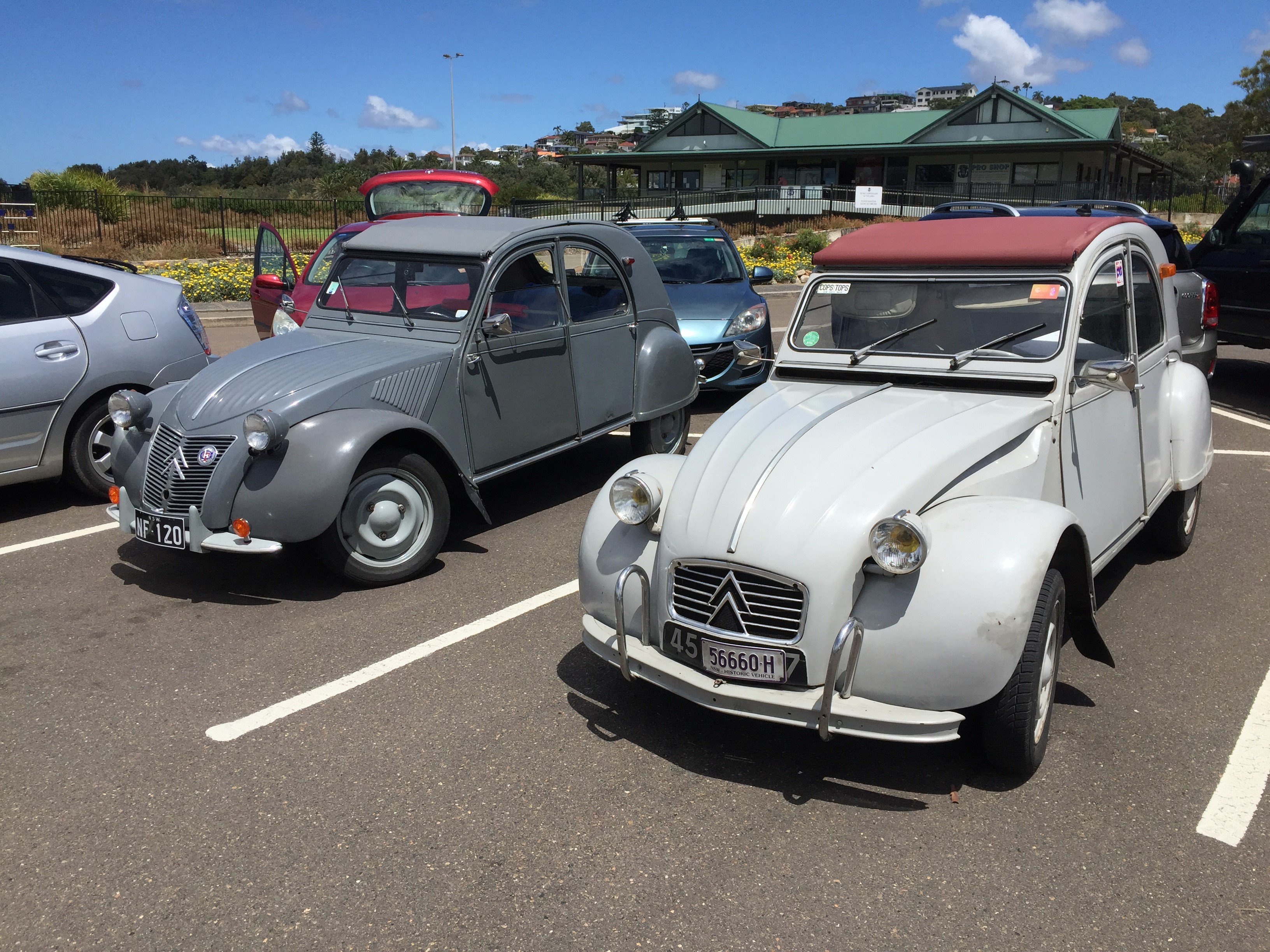
Ray's other twin cylinder Citroen 2CV
What was your grandmother’s name?
Elsie May Bevan. We moved to Palm Beach in 1950 buying a house in Nabilla Road. My grandmother had the opposite corner property, which was the second ? post office in Palm Beach, and was known as Bluey’s Corner.
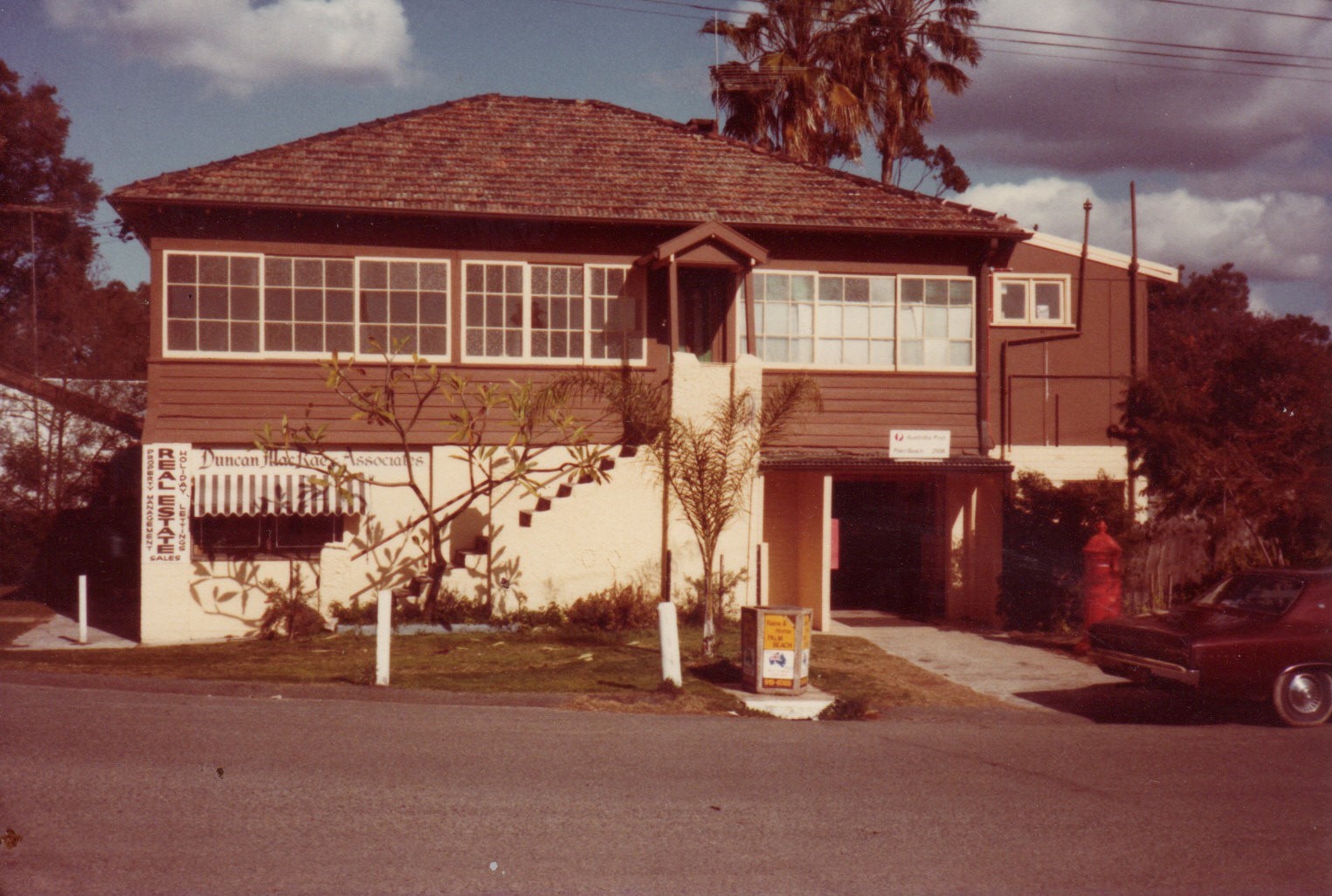
'Bluey's Corner'; Elsie May Bevan's home
What did you do for play while at Palm Beach?
There wasn’t much time for any of that. From 7 o’clock I’d be working at the garage, In the afternoon I was deckhand on the ferry service on The Basin run and In the evening I was projectionist at Avalon Theatre 1957/8. I started at 7 and finished at midnight, at 17 ……… easy.
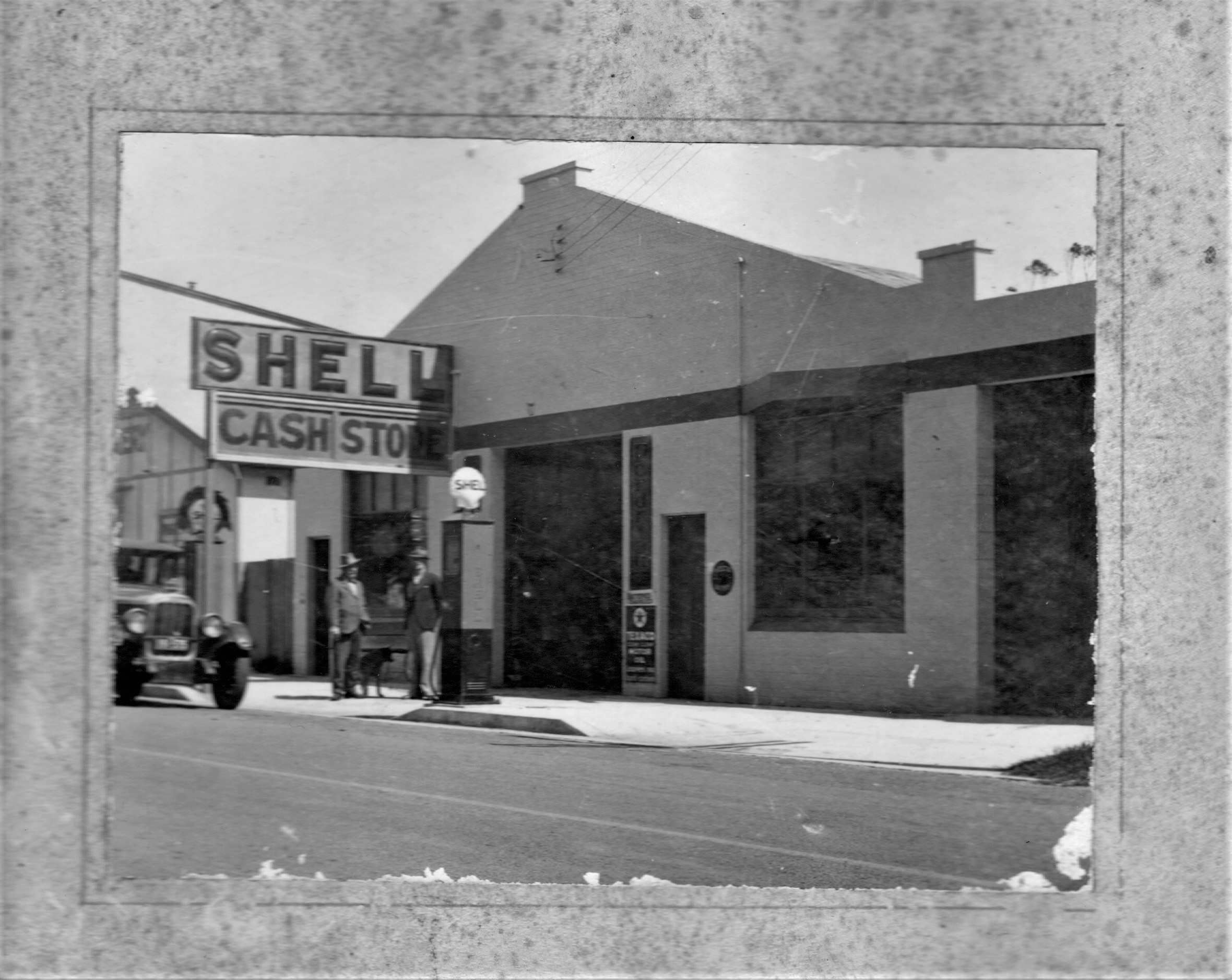
NOTICE is hereby given that the partnership heretofore existing between the undersigned Jack Lewis Rigney and William John Henman, carrying on business as garage and service station proprietors at the corner of Barrenjoey and Iluka roads, Palm Beach, under the name of Palm Beach Garage, was dissolved by mutual consent on the 19th October, 1953. All debts due and owing by the said late firm will be received and said by William John Henman, who will continue to carry on the business under the same name at the same place.—Dated at Sydney, this nineteenth day of October, 1953. JACK L. RIGNEY. Signed by the said Jack Lewis Rigney in the presence of,—W. J. C. Forsyth, Solicitor, Sydney. J. HENMAN. Signed by the said William John Henman in the presence of W. J. C. Forsyth, Solicitor, Sydney. 3160—£1 5s. NOTICE is hereby given that the partnership heretofore (1953, October 23). Government Gazette of the State of New South Wales (Sydney, NSW : 1901 - 2001), p. 3555. Retrieved from http://nla.gov.au/nla.news-article220297733
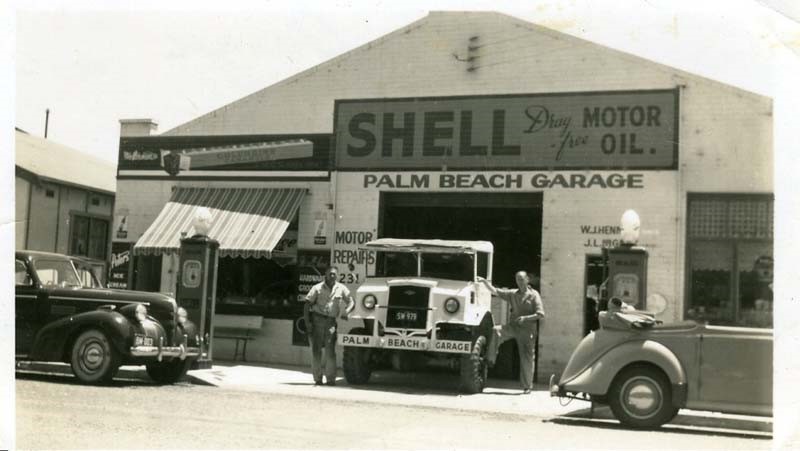

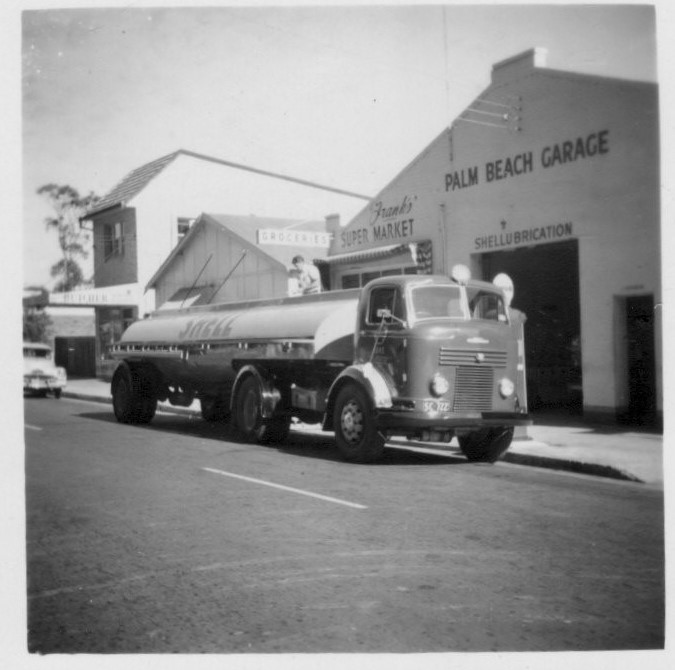
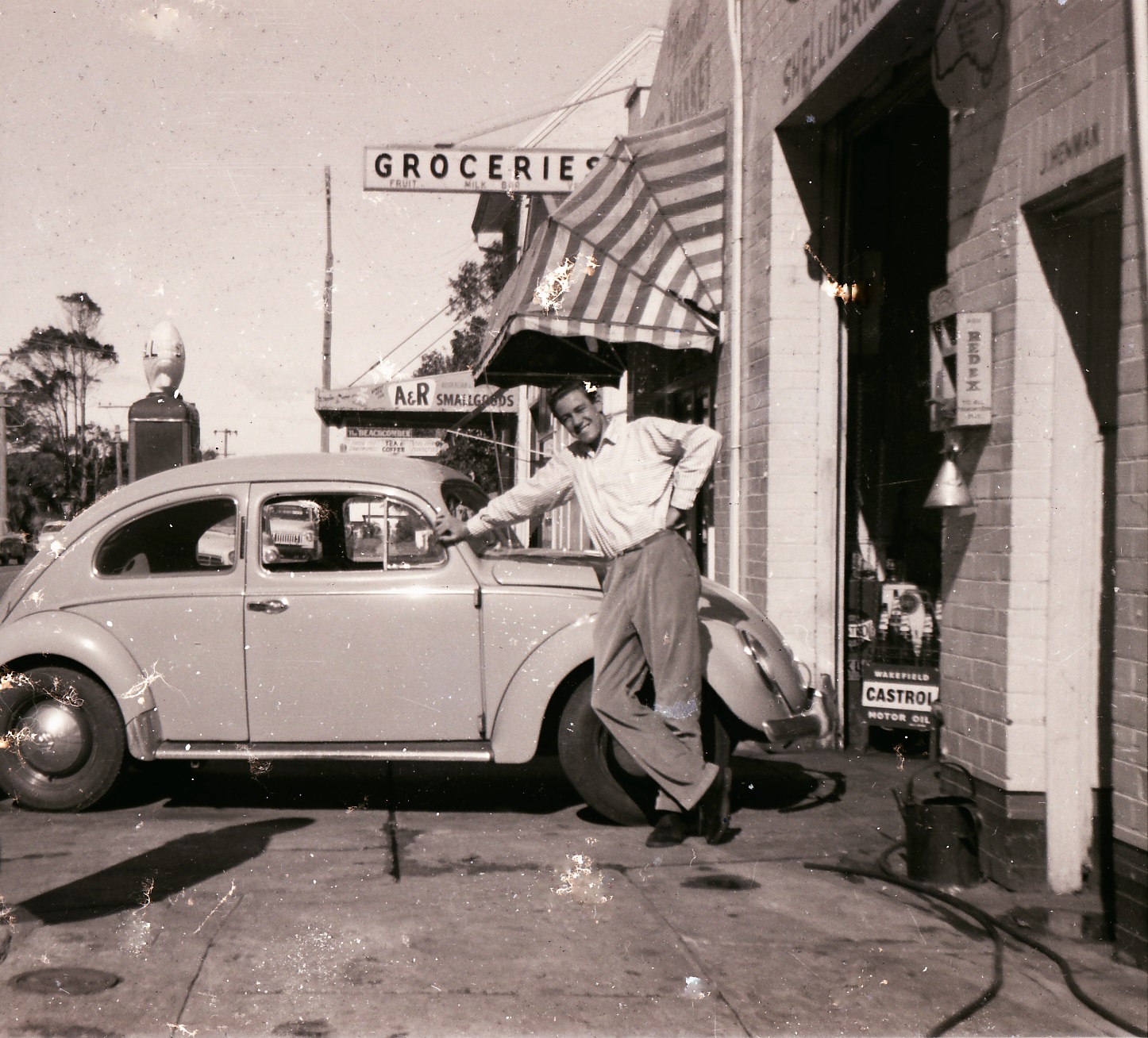
Ray outside the garage as a youngster

NOTICE is hereby given that the partnership heretofore existing between the undersigned Jack Lewis Rigney and William John Henman, carrying on business as garage and service station proprietors at the corner of Barrenjoey and Iluka roads, Palm Beach, under the name of Palm Beach Garage, was dissolved by mutual consent on the 19th October, 1953. All debts due and owing by the said late firm will be received and said by William John Henman, who will continue to carry on the business under the same name at the same place.—Dated at Sydney, this nineteenth day of October, 1953. JACK L. RIGNEY. Signed by the said Jack Lewis Rigney in the presence of,—W. J. C. Forsyth, Solicitor, Sydney. J. HENMAN. Signed by the said William John Henman in the presence of W. J. C. Forsyth, Solicitor, Sydney. 3160—£1 5s. NOTICE is hereby given that the partnership heretofore (1953, October 23). Government Gazette of the State of New South Wales (Sydney, NSW : 1901 - 2001), p. 3555. Retrieved from http://nla.gov.au/nla.news-article220297733




Ray outside the garage as a youngster
Where did you go to school ?
I first went to Balgowlah Primary in Seaforth and then for the last six months after the move I went to Newport Public School. For High School it was back to Seaforth to Manly Boys’ High then known as Shack town.
And you knew Tommy Gilbert?
Very well. Tommy, Peter Verrills, Geoff Verrills and myself caught the 142 bus to Manly to attend High School, later Tommy joined the Avalon Narrabeen Tyre Service near where the Chelsea Tea House is located. He took over some of the jobs that my dad’s garage couldn’t handle, we were closely aligned and grew up together riding push bikes.
You ran a small theatre at the Garage?
I wanted to get into films, so yes, that's how I started. Dad said to me one day: ‘time to put Henman & Son over the portal, which means you’ll have to do a Tech. course.’
I said I was sick of grease, 'I love old cars but I want to get into films’.
Subsequently he bought a 16mm Bell & Howell projector modified the lubritorium and took out the hyboys (oil pumps) and replaced them with director’s chairs and a screen.
I was then at Manly Boys’ High on Harbord Road. On Friday afternoons after school I’d catch the Wynyard bus to the city and pick up the movies including the Cinesound Review and serials etc from the various film distributors. I’d get back to Palm Beach at about 7pm on the 150 Albion at which time the local village were all in the cinema having a Friday evening drink. Half of them were a bit sloshed so whatever I showed they loved.
Those attending included Jack Ellis who had the milk bar adjoining the Garage, Geoff had the coal fired bakery, Gonsalves had the butchery, next was Toranto’s fruit shop, Alf Curtis the Pharmacist and finally Langford’s Real Estate Agency. The RSL was still located at Sandy Point in a garage. Our Theatrette ran Friday, Saturday and Sunday nights with a Saturday matinee – it was a real hub.
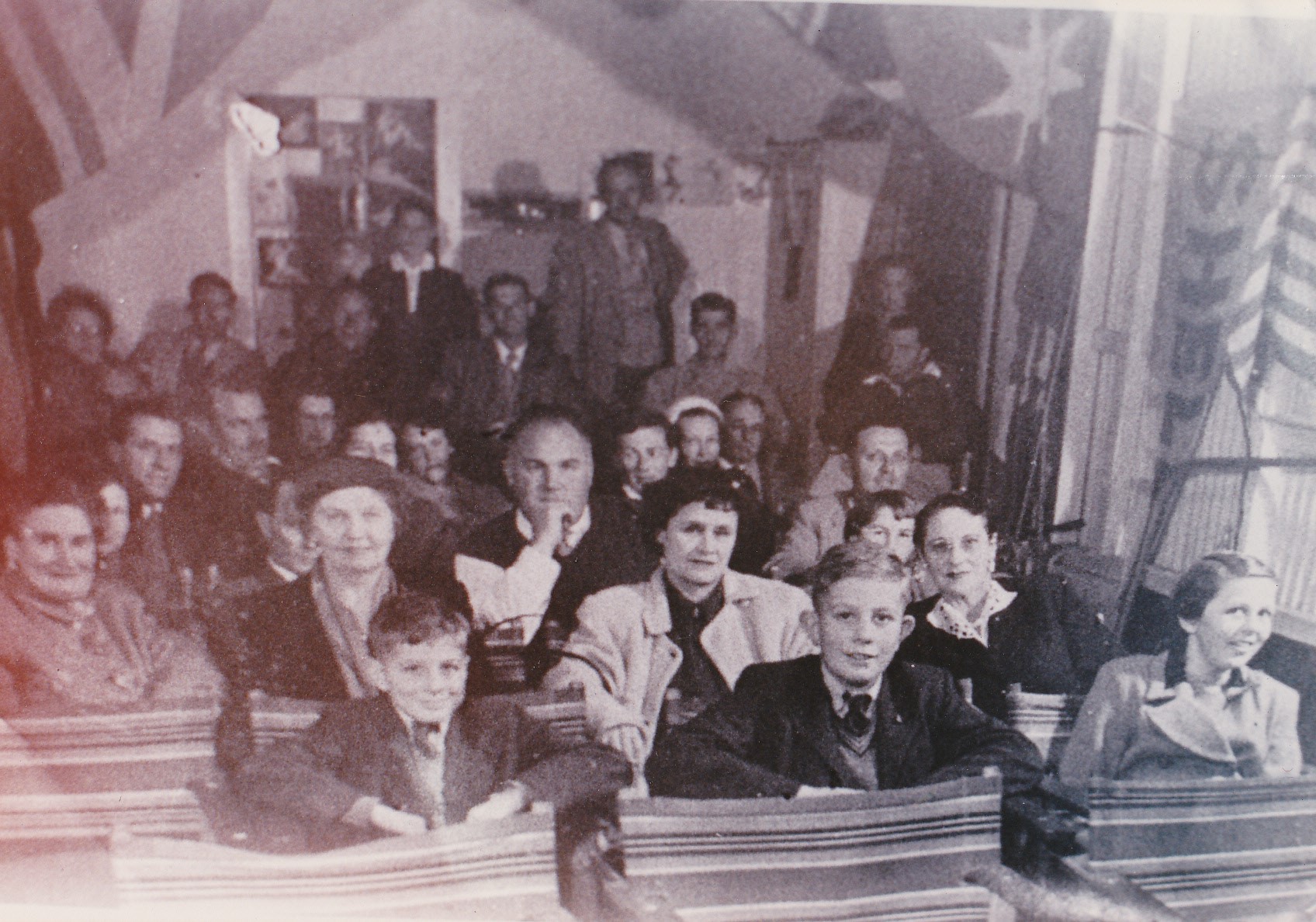
The Palm Beach Cinema - 1953
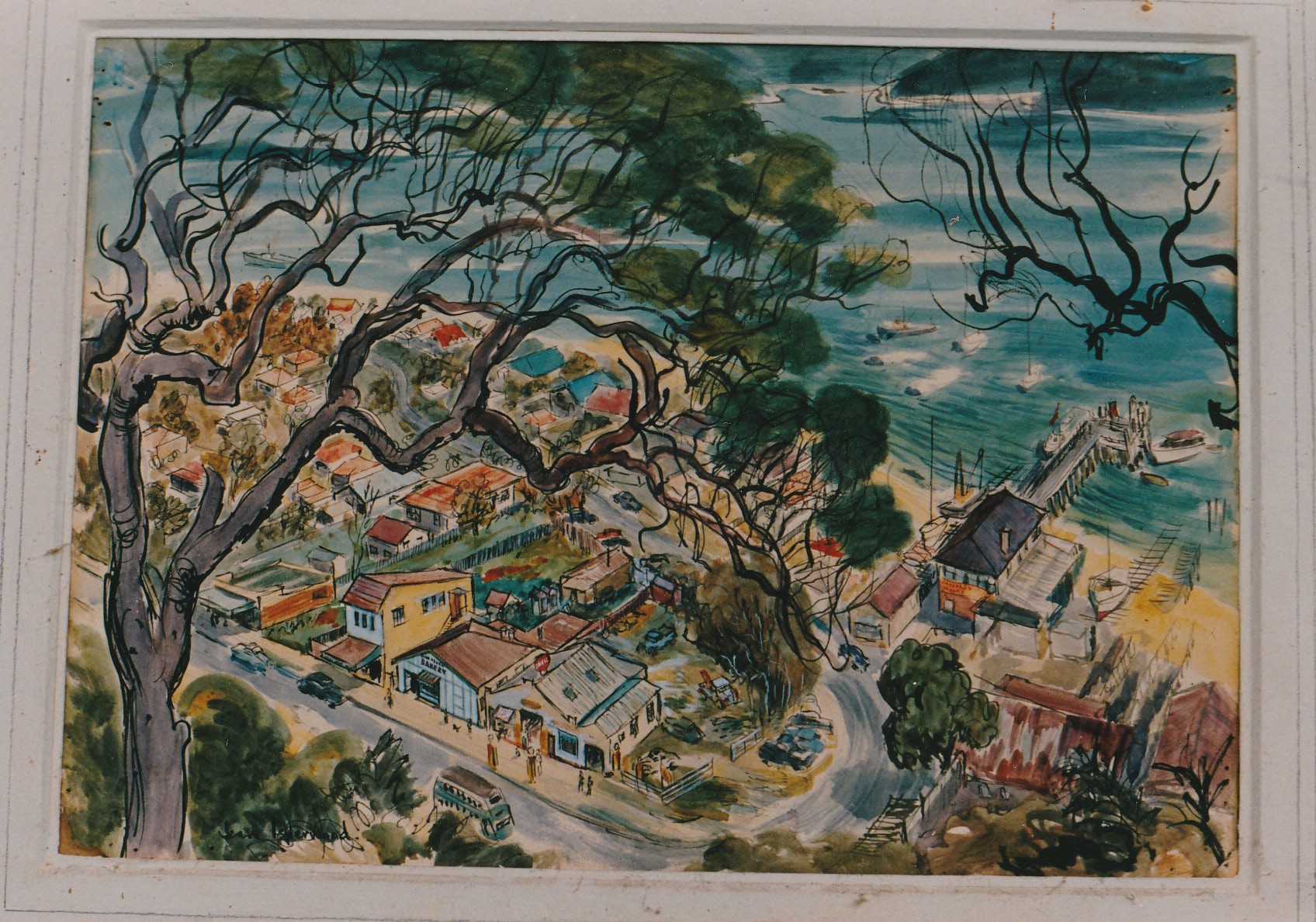
1952 painting by Jean Isherwood. This shows the Garage, Ellis Milk Bar, Butchery, Toranto's Fruit Shop, Alf Curtis's Pharmacy and Palm Beach Estate Agency. Ray's picture.
So you ended up working down at Avalon Cinema as the projectionist?
Yes.
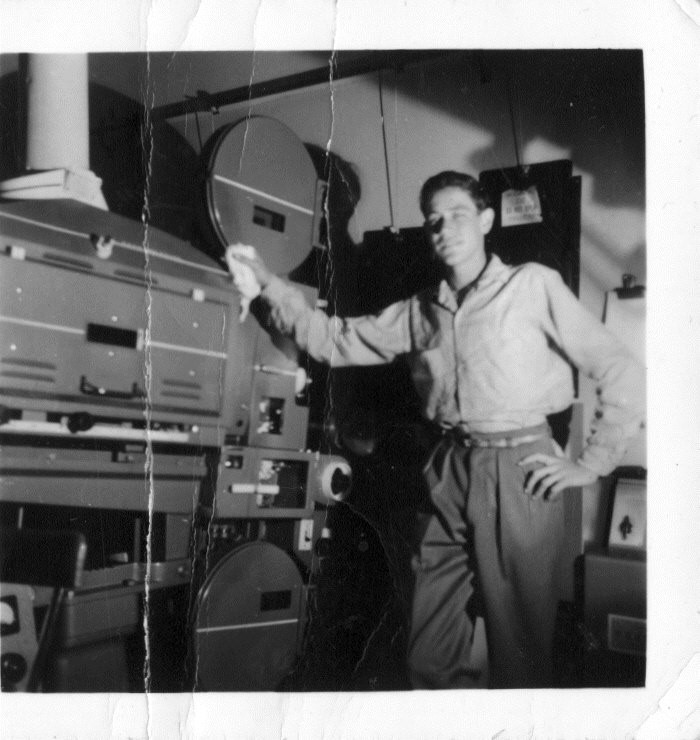
Ray - Projectionist
How did you change that from showing films to making films – what was the process?
When Avalon Theatre was built in 1955 by 1957, we had closed our little cinema and I joined Avalon Theatre which built specially for CINEMASCOPE. – I got to know all the movie titles and stars of the day including the directors. Jack Gallbraith would deliver the big Maspro canisters twice a week at program change and I’d make up the program in the morning by splicing in the news and trailers. The Queen’s National Anthem was placed at the head or tail of the program. I’ve still got a 35mm copy.
I worked 6 nights a week and loved it. When the program was running late for whatever reason, I’d have to look out the window to see if the 150 bus was coming around the top of the golf course. I’d dash over and ask the bus driver to wait until we got out – ‘can you give me 5 minutes?’ – they always did.
One of our customers was Paul Jacklin who owned a Mercedes 190SL which I looked after. He was the boss at the J Walter Thompson advertising agency and told dad he thought I should get into Television he offered me the choice of Ch 9, 7 or the ABC. Three days later I was working at TCN Channel 9 and that was very exciting. I started in the lighting Department but I wanted to get onto camera so every moment I got I was pushing cameras, initially on the news with Chuck Faulkner. He was reading the news before Brian Henderson came along. Six months later I became a cameraman.’
Every week I worked on the Bobby Limb Show, Sound of Music, Bandstand and my favourite the DAVE ALLEN SHOW plus outside broadcasts, including the memorable FRANK SINATRA SHOW at the old Sydney Stadium at Rushcutters Bay in 1961 (Never shown as a complete program in Australia.)
I used to collect the kines of the day (16mm tele-recordings). Sadly, in those days news footage and other recording of the day were trashed. The ABC also had a skip outside their Gore Hill Studios where they also junked certain programs. I used to go around the bins and retrieve them up!
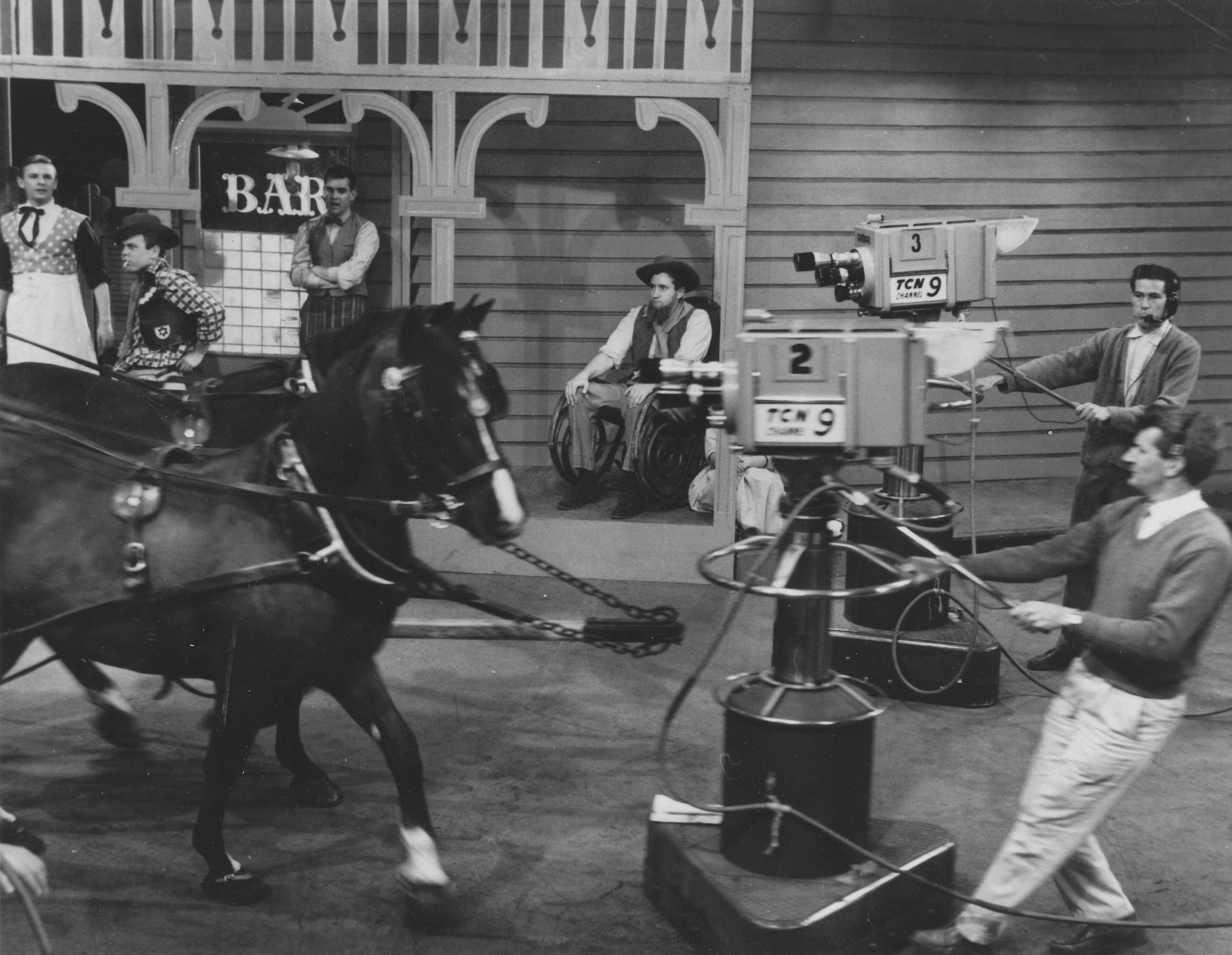
Channel 9's Studio 2 - 1962
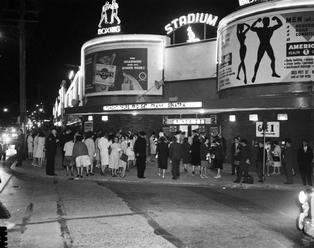
Sinatra at Sydney Stadium - December 1961
What are you going to do with them – give them to the NFSA (National Film and Sound Archive)?
Yes, some of my collection is there now.
I think you may be contacted by people once they figure out where their tossed out stuff may have been saved…. this page does get read you know….
For Ken G Hall’s retirement there was little news coverage. I’d just bought a Sony Betacam which I used to record his retirement party, the NFSA has a copy of my footage.
The country is lucky it has the Cinesound and Movietone newsreels digitised for future generations.
How long were you at Channel 9?
Seven years, 1959 to 1966.
What did you do next?
Towards the end of 1965 some friends from the ABC were planning a working holiday in London as you did in those days. I hesitated about joining them until I met up with my cameraman friend Jeff, at the 729 Club where he presented me with a 150 pound ticket on Chandris Lines Ellinis,…… we departed in January 1966.
I went to see Bruce Gyngell, who was then Program Manager, and told him my plans. He wished me well and gave me a year off.
We arrived in London to a bitter cold February and set about looking for accommodation.
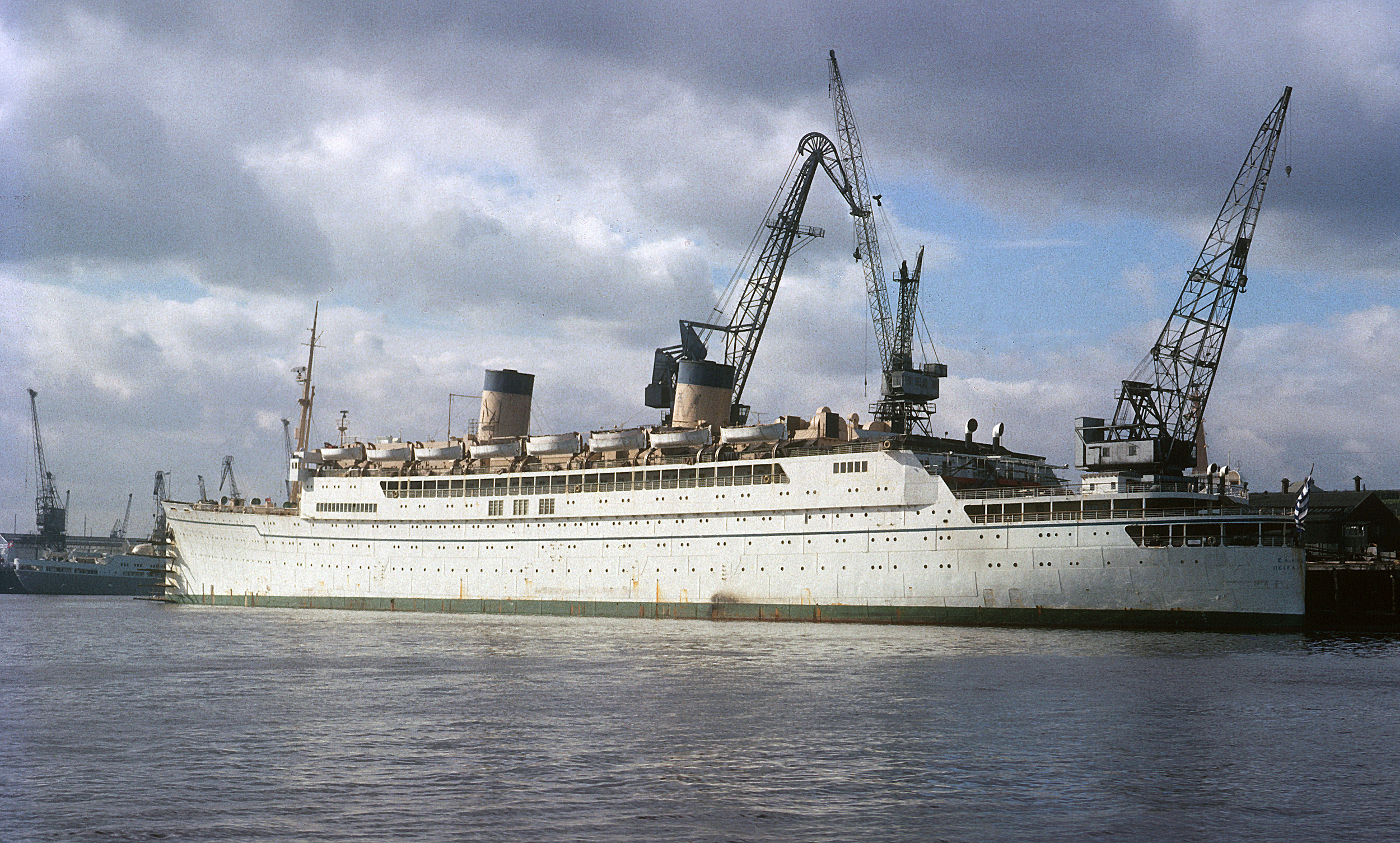
The liner Ellinis at the shipyards Swan Hunter of Newcastle in 1963. Photo courtesy Malcolm Donnelly
How old were you then?
I was 25.
We arrived at Kings Cross Station where there was overnight accommodation in private hotels. We eventually found a flat near Regents Park on the Camden Town downmarket side. Five of us moved in downstairs and by coincidence five Australian girls from another boat moved in upstairs.
The Queen’s Tavern was a quaint old pub on the corner where cameraman Geoff became barman, Art, a video tape technician, joined Multi Broadcast repairing television sets, John, studio sound engineer worked for Pay TV and Arthur was readily employed in his profession as school teacher.
I thought ‘projectionist’ would see me through whilst I wrote off to the various TV outlets. I looked down the pages of the Evening Standard and there were all these ads for ‘Projectionist’ and ‘assistant Projectionist’. One was for a position at The Plaza Cinema in Piccadilly Circus so I rang them and they said yes, please come in, meet at the stage door in Jermyn street’.
This theatre was absolutely magnificent. It was owned by Paramount Pictures and showed mostly their product. The old Projectionist who interviewed me had been there through the war years and he had two old Simplex projectors, much older than the ones we had in Sydney, these were supplemented by two brand new Phillips 70/35mm projectors – magnificent – London has kept so many beautiful Theatres where Australia has destroyed so much of it’s architectural heritage. The Plaza still had an organist at most sessions, a pull curtain and a drop curtain, plus all the stereo refinement of 70mm.

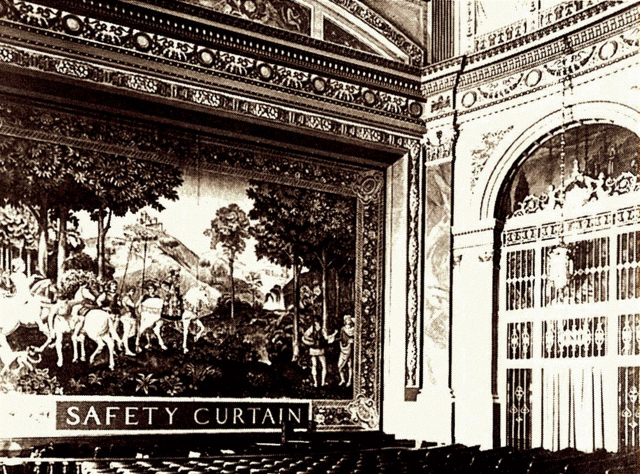
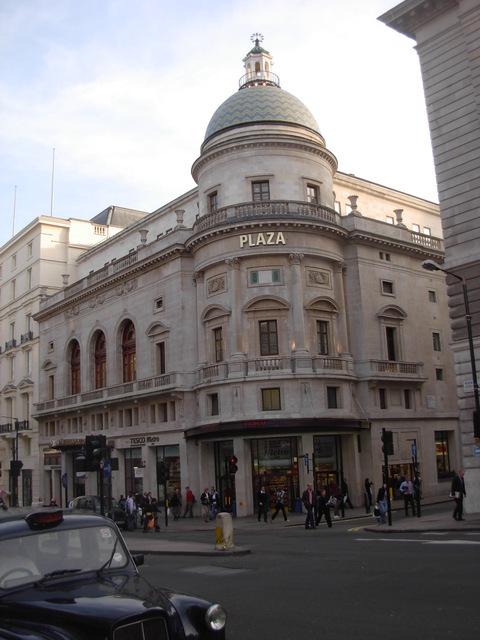
Interior and exterior of The Plaza Cinema; three tiers inside - sourced from Cinema Treasures and Arthur Lloyd UK
The catch was that this was a non-union theatre, so they paid about half the going rate, consequently, they could never hold staff, when they offered me 9 pounds a week I said ‘ that’s a third of what I was getting in Australia, you will need to do better than that.’ To which they replied that they’d give me luncheon vouchers and bus fares at night. That still didn’t add up – even at that age I wondered how Paramount Pictures could be so penny-pinching ?. The upshot was they said they’d ‘find’ me another couple of quid. Not only did you come in to run the movies, but they also ran off a generator most of the time again to save money? – I thought this is crazy, it was an old gene which I was used to coming from the garage. They said I’d need to start the gene on certain shifts.
After a week I was made up, the old projectionist said ‘I will retire soon, I love my job and I’m trying hard to keeping my faithful old projectors but I’m having difficulty with the cue marks you’d better do the changeovers. We worked together for a week and then he said ‘you are now the night projectionist, your money is going to go up to £12 a week.’
The sessions were 11am 2pm, 5pm and 8pm and 11pm show on a Saturday.
The first night I came in my assistant didn’t turn up, he’d given up because of the money. We were showing Otto Preminger’s 70mm production of ‘In Harm’s Way’, which was a dreadful black and white film with John Wayne winning the war yet again.
I’d promised to show the Pathé news and the adds on the old projectors, with an assistant that’s ok but frequently without an assistant you were chasing your tail. Running 70mm prints and 35mm yourself was a task.
I went down to the car racing at Brands Hatch on a long weekend with the boys, I’d bought a 1932 Vauxhall for £10, that was getting us around London late at night – the Tube would stop, the restaurants would shut – there used to be a caravan parked outside Earls Court Tube Station selling stale sandwiches, and that’s where you got a snack after 11pm, BUT London was ‘swinging’, the girls were pretty and the skirts were short …..
Meanwhile on the way back from the race meet we visited a couple of pubs, I was conscious of having to be back for the 11PM session at the Plaza. I dropped the guys off at a tube station and parked illegally on Lower Regent St.
Once again my assistant didn’t show up. I began the show by buzzing the organist to cue him to complete his piece prior to the Pathé rooster intro, the lights dimmed the curtains opened and the program had begun. Being a bit under the weather I ran the whole program on the 70m projectors.
All went well until we got to the last hour of “IN HARMS WAY” ……. I was half asleep sitting watching the big spools rotate, at the same time I was conscious of some laughter from the audience ? this was not a funny film !, one of the usherettes entered the booth saying ‘there’s something wrong with the sound,’ the meters were responding the screen was bright ? I listened outside the box and there was John Wayne walking from one side of the screen to the other, the centre sound track had totally cut out …. what to do ? The theatre carried a stand by 35mm print, I disappeared into the rewind room and selected the approximate spool, laced up the old Simplex, adjusted the masking, switched the sound and the screen went yellow on one side blue on the other as the arc ‘found it’s rhythm’, Wayne was once again in full mono. When we got out 20m early I realised I had selected the wrong spool ! ‘Wer’e out early Henman’ said the manager, ‘must be the mains voltage,’ he just shrugged, he had been out all night ‘fraternising’ with one of the usherettes!
We then had the premiere of the next Otto Preminger film BUNNY LAKE IS MISSING – the Plaza had all the bunting and flags out , a big night – the next day Otto sent me £5 for ‘the presentation of his film’. I still have it.
The following week I was going through the Evening Standard and saw an ad for the BBC’s Ealing Studios, ‘Assistant Cameraman required for a three month holiday relief contract’
During Summer a third of their crews go on holiday, they had 50 full crews then, it was the biggest film unit in the world.
With my experience I was employed immediately, I signed up for the three months and within two days was on my first job. This was with Alan Whicker who achieved. A 15m audience per program, It was more than a three-month trip overseas, Japan, Philippines and Singapore. I said ‘I’m only working for you for three months’ ‘don’t worry’ said one of the sparks, ‘it’s only Beeb paperwork’
So that started me off really well, I finished up shooting 25 documentaries with Alan, 10 of those later in Oz.
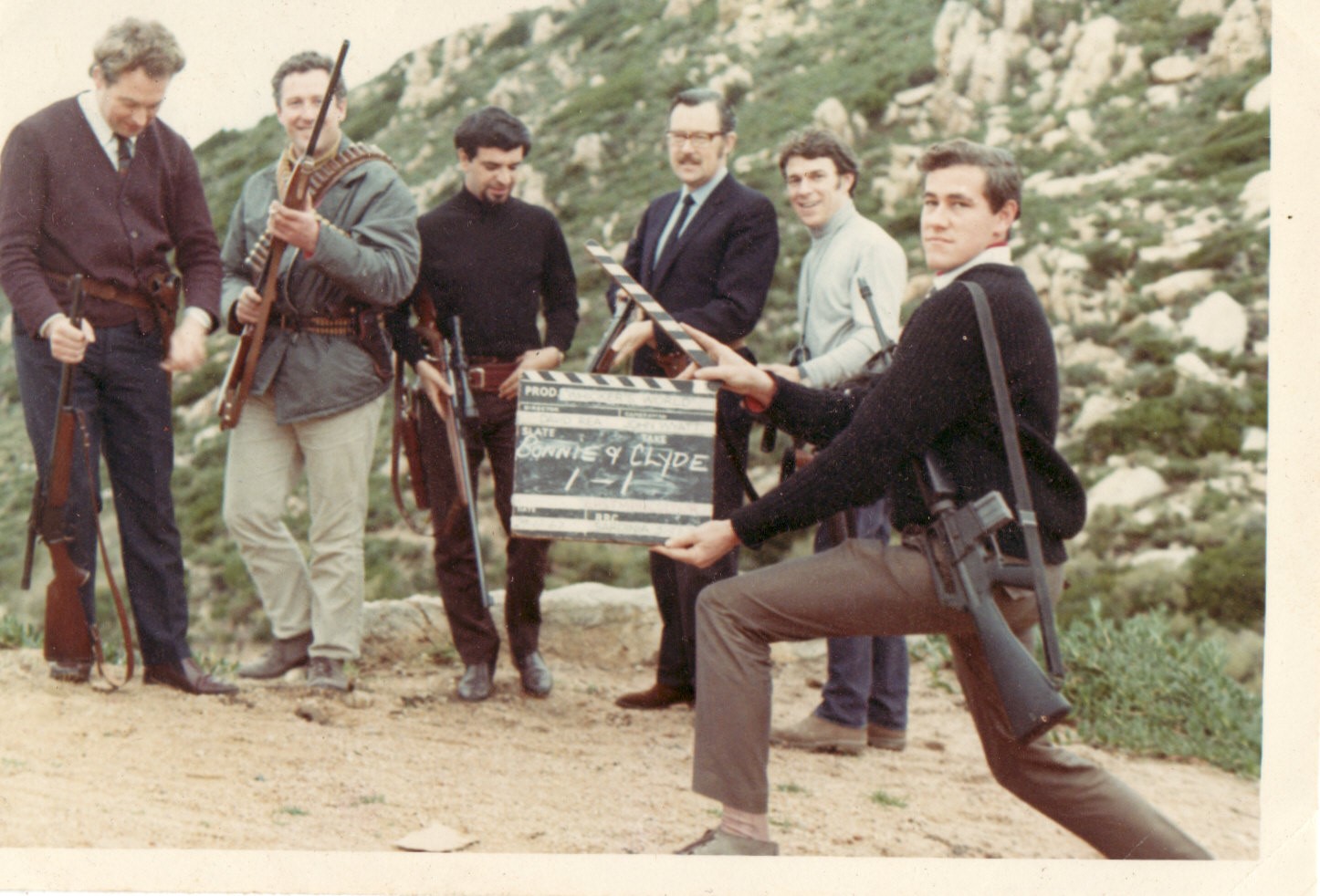
Alan Whicker "Bandits of Sardinia" - 1967, that's Ray holding the clapboard, Alan is at the back with the moustache
What were your favourite projects then?
That’s easy ! It was having the privilege of working with David Attenborough for 5 years – he is fantastic, a wonderful man. Although I was based at Ealing Studios, some crews would at times be at Television Centre in the East Tower where documentary films were produced for BBC 1 and BBC 2. During those years David was head of BBC 2. One day he joined myself and June and other friends at the Club Bar and told us he was resigning from that position and would be back on the road making films. He asked me if I would like to join him on the first series -TRIBAL EYE this was to be followed by LIFE ON EARTH.
On completion of the film we were then faced with the drive from Ibadan to Lagos quoted in the Guinness Book of Records as being ’the worst road in the world’ ……. correct !!
We were travelling in a Kombi, in Nigeria you have to have a driver in certain areas. Ours only knew one speed … flat out even through the villages. The reason he explained he was responsible to take to hospital any one he hit AND was responsible financially …… work that one out !
What was referred to as a road looked more like a bombed out war zone consisting of craters where Minis would disappear, these craters combined with dead camels, overturned petrol tankers, bikes scooters and horses fighting for space was a real challenge.
If we were to get to Lagos in 10 hours we would have to drive ourselves. The driver refused to slow down so at the next tea break we tied him up and placed him in the back ……. He was not a happy passenger to Lagos.
We arrived in a frazzled state only to find the President had taken the Nigerian Airways 707 on a shopping holiday with his family so we had to re negotiate a flight in three days time!
We also shot a TRIBAL EYE in Canada on the Red Indians. The later shoot in Australia for LIFE ON EARTH continued the adventure. One memorable shoot was in the Naracoorte Caves in South Australia where the undisturbed bones of 3m kangaroos that died out about 30,000 years ago.
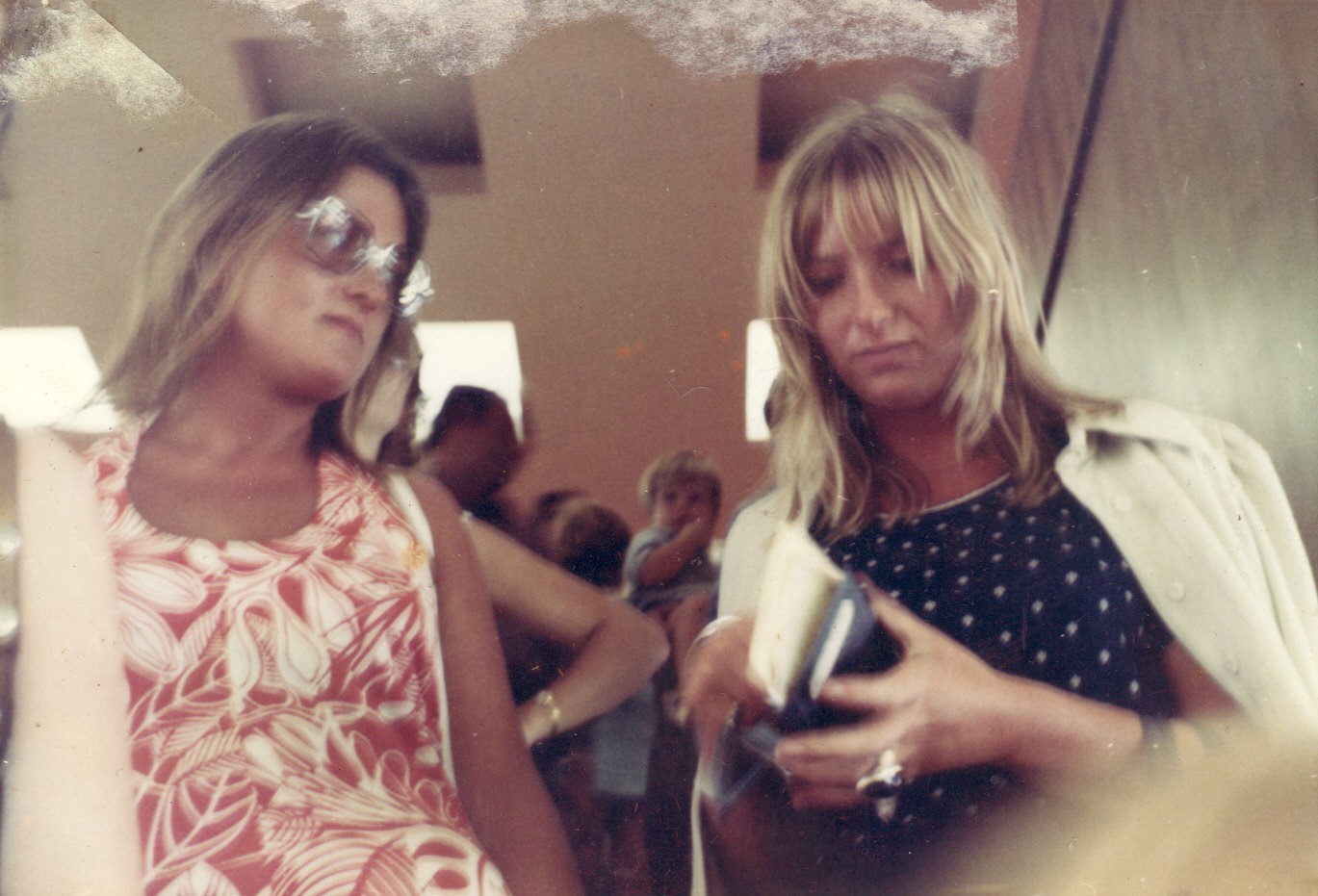
June and friend in the BBC Club bar ..... where Ray meets David Attenborough
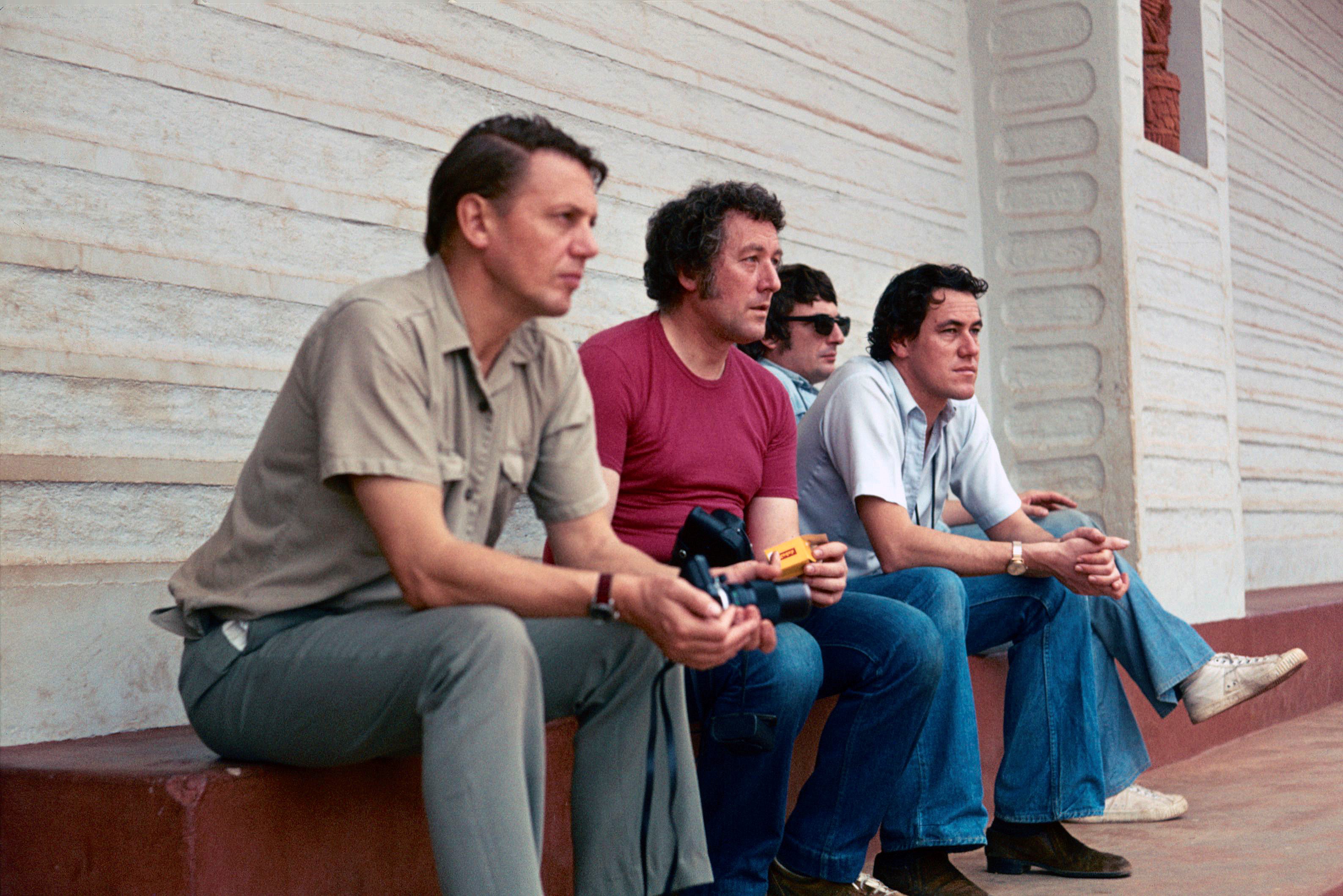
David Attenborough on left, Ray second from left
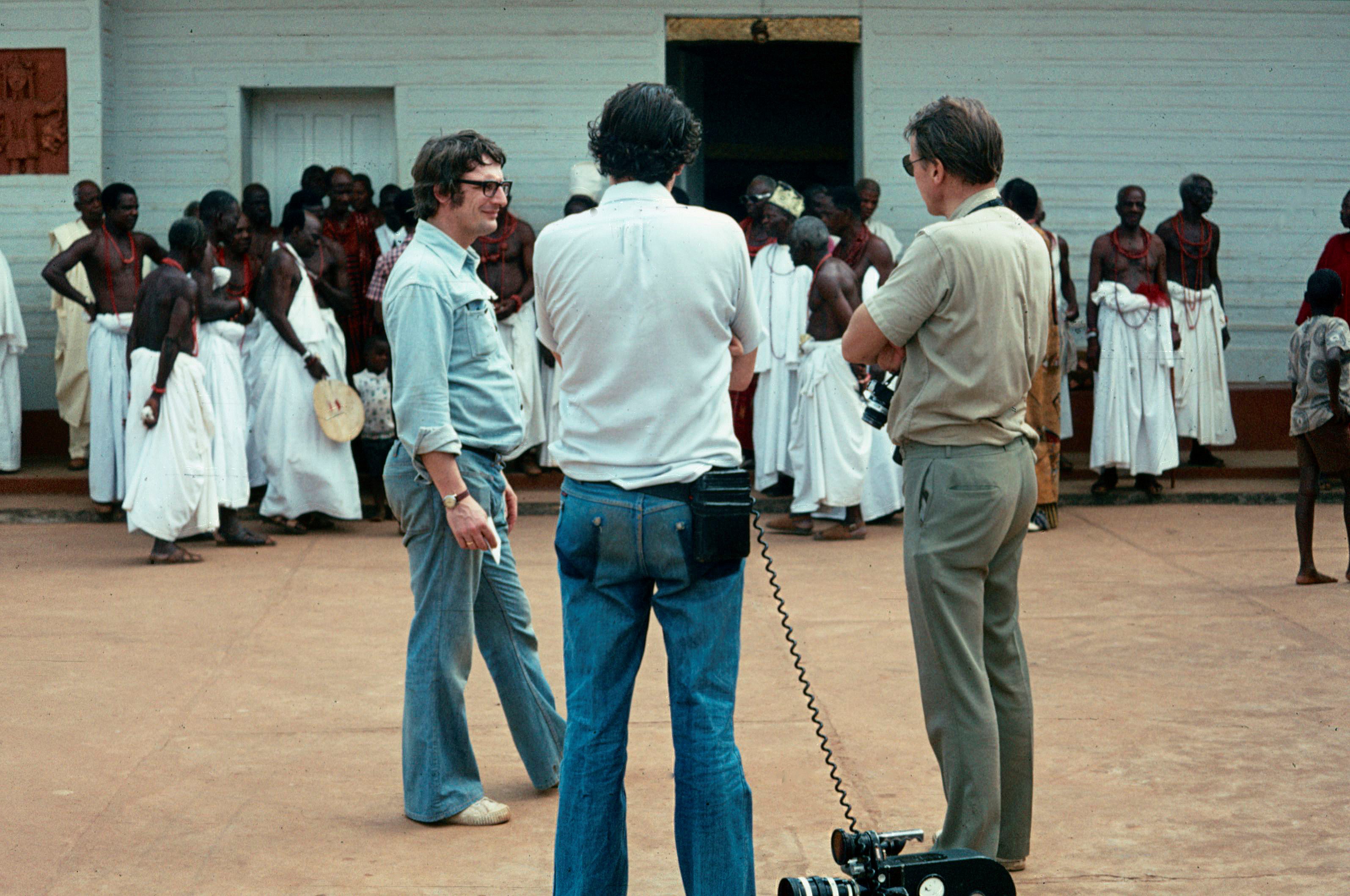
In Nigeria: David Attenborough on right, Ray in the middle, Director on the left
Which was your favourite shoot with him?
I think Nigeria was probably the most memorable because of the sub-adventures. The old lady that had this beautiful old mansion that was falling apart and was full of monkeys – Susanne Wenger. She was an absolutely fascinating woman, living by herself then, and these monkeys followed me all over the place. David loves people, so you get talking and extend the shoot a bit more and take more time. All the Australian filming was always interesting as well.
How did you meet your wife? She was working at the BBC too wasn’t she? You married in England?
June worked in the Documentary Department of the BBC based at Television Centre. She and I met in 1968 whilst working on a documentary with Malcolm Muggeridge in Washington DC. She came out to Sydney to meet me for a holiday at the end of 1969. After filming the Snow Goose in 1971 I joined her in Jerusalem again on a BBC 1 documentary. We married in November of that year.
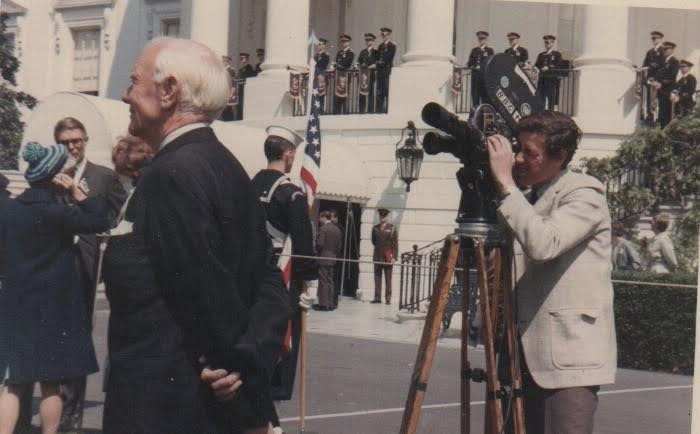
With Malcolm Muggeridge in Washington DC; Mr. Muggeridge to the left, Ray filming, White House in the background
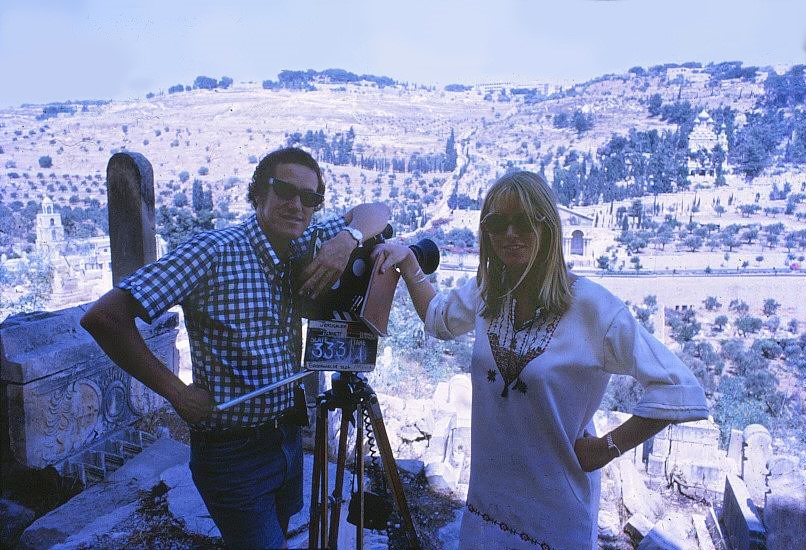
In Jerusalem - Ray and June
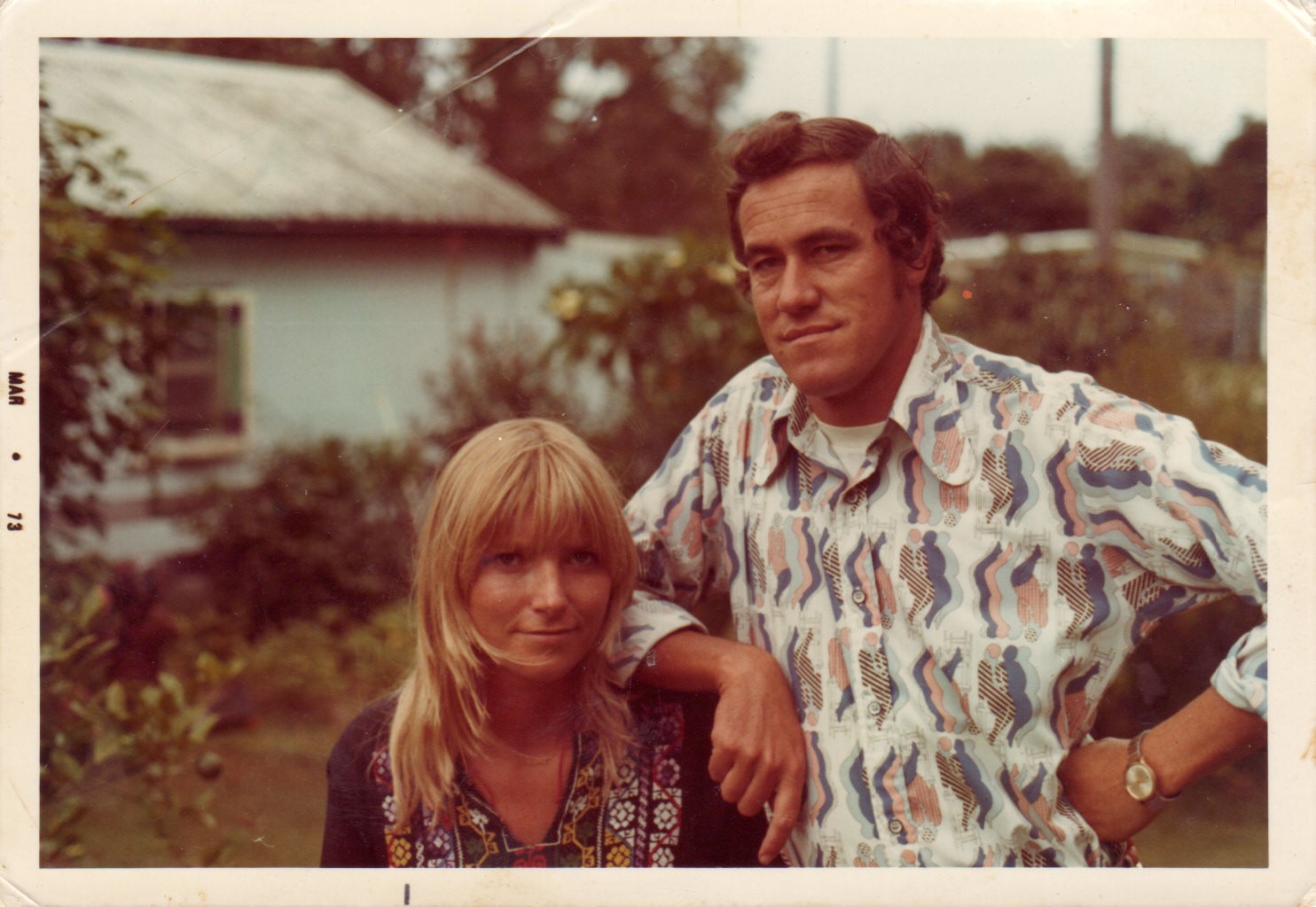
Ray and June at Palm Beach Henman home at 2 Nabilla Road in 1969
How long were you with the BBC?
Ten years in UK and the world and 30 years based in Sydney.
Could you share a few insights from then ?
As part of what I did there I filmed the Queen’s Christmas Broadcast for six years.
How that came about was one of the very first shows I worked on was an Earls Court Billy Graham presentation. The Head of that was a man who worked in documentaries called Richard Cawston, who June worked for. He gave me a camera and I was busy just putting in magazine after magazine recording the whole ten minute runs. They needed some shots so they handed me a Bolex camera and said ‘can you go and get some cutaways.’ So I went around everywhere and shot about 200 to 300 foot of undercut rolls. He later came to me and said he’d used every inch of film footage I’d shot.
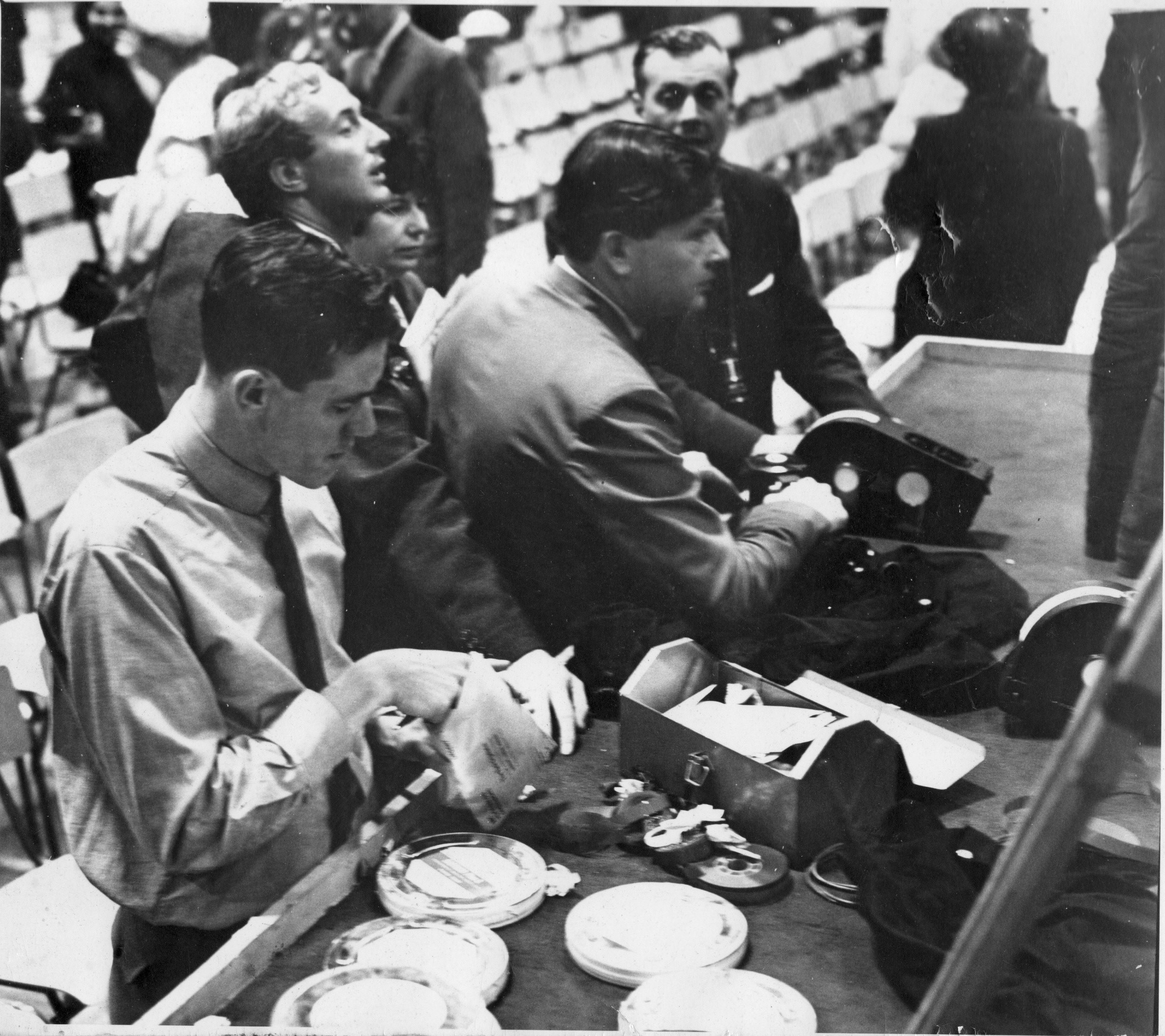
Ray - Earls Court work; Ray is closest to camera
In 1968 Richard Cawston directed ROYAL FAMILY, he was the head of documentaries and it was a year in the making, Peter Bartlett (R.I.P.) was the main cameraman and I was brought in as 2nd camera. I was fitted for a Saville Rowe suit and given a gold crown pass which opened many doors on Royal occasions. After the documentary Peter then moved into the drama department. It was then that Cawston promoted me together with my assistant Philip Bonham-Carter to film the Christmas message for six years also the Prime Ministers conferences. One meeting was in Ottawa when Gough Whitlam was in office. He asked myself and another Australian cameraman why we weren’t back in Australia supporting the film industry.
I also filmed in Rio when the Queen travelled on board the Britannia for part of the ROYAL FAMILY shoot.
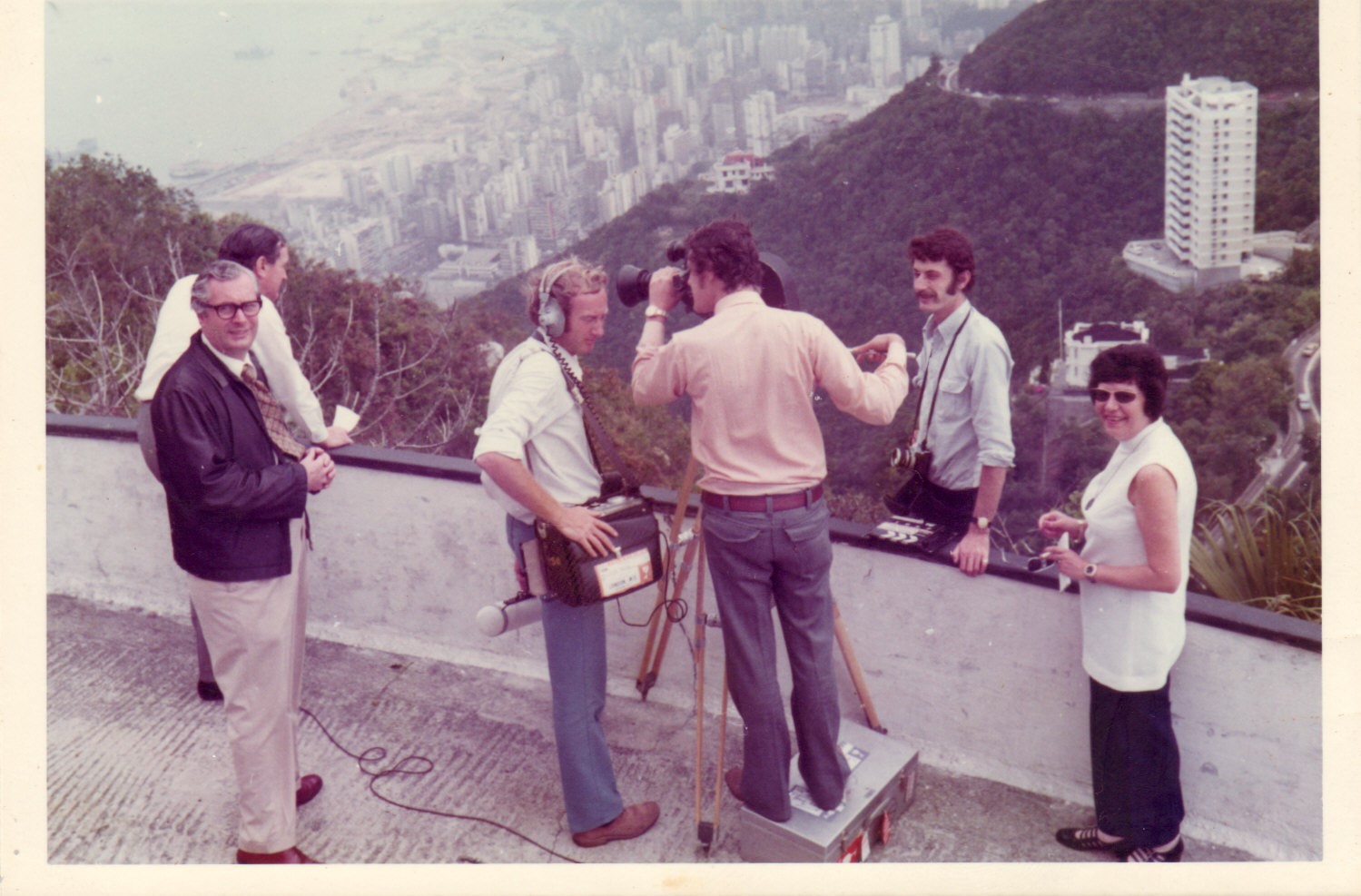
"Royal" crew in Hong Kong
In the early 70’s one Christmas broadcast became a bit of a challenge. PM Edward Heath had taken on the coal miner’s union, the miners wanted clarification on mine closures and blackouts were occurring particularly in the north of England they were slowly creeping south. Heath nicknamed ’The Grocer’ dug in his heels.
I remember three days before the actual recording was scheduled, the gaffer and myself went to the Palace to do a rece and check out where we were going to film the message. I looked at the blackout situation and said to Dave ‘do you think these blackouts will reach London’ …’ ‘na bruva, they wouldn’t dare black out Westminster and the Palace.’ ‘has the Palace got a main generator ?’ ‘I asked ‘must ‘ave’ was the cautious reply. I asked him to check. It turned out, they didn’t, they just had little portables but no main generator. I said we should order a 15 kilowatt gene just to be sure, and park it outside the Regency Room – “think yer overtrainin’ but I’ll order one just to be on the safe side. ‘
On shoot day we were due to film at 5 o’clock, the blackouts had reached North London, we set up for filming cabling up the gene at the same time.
At 5pm the Queen arrived and began making adjustments to Autocue. At 5.30 we began filming but after 5 minutes the Palace went to black …… The Queen said ‘it must be a local fuse’ no ‘Ma’am, it’s the whole Palace, our gene had come to life and the lights faded up. Panic in the rest of the Palace, household staff were running around lighting candles, corgis were barking and Princess Anne came in to see how we were doing.
An hour later we had finished the recording, the Queen said she had some letters to write so we left the generator running and left one of the sparkies to refuel it till the mains came on again ….. that didn’t happen till 2 am the next morning!
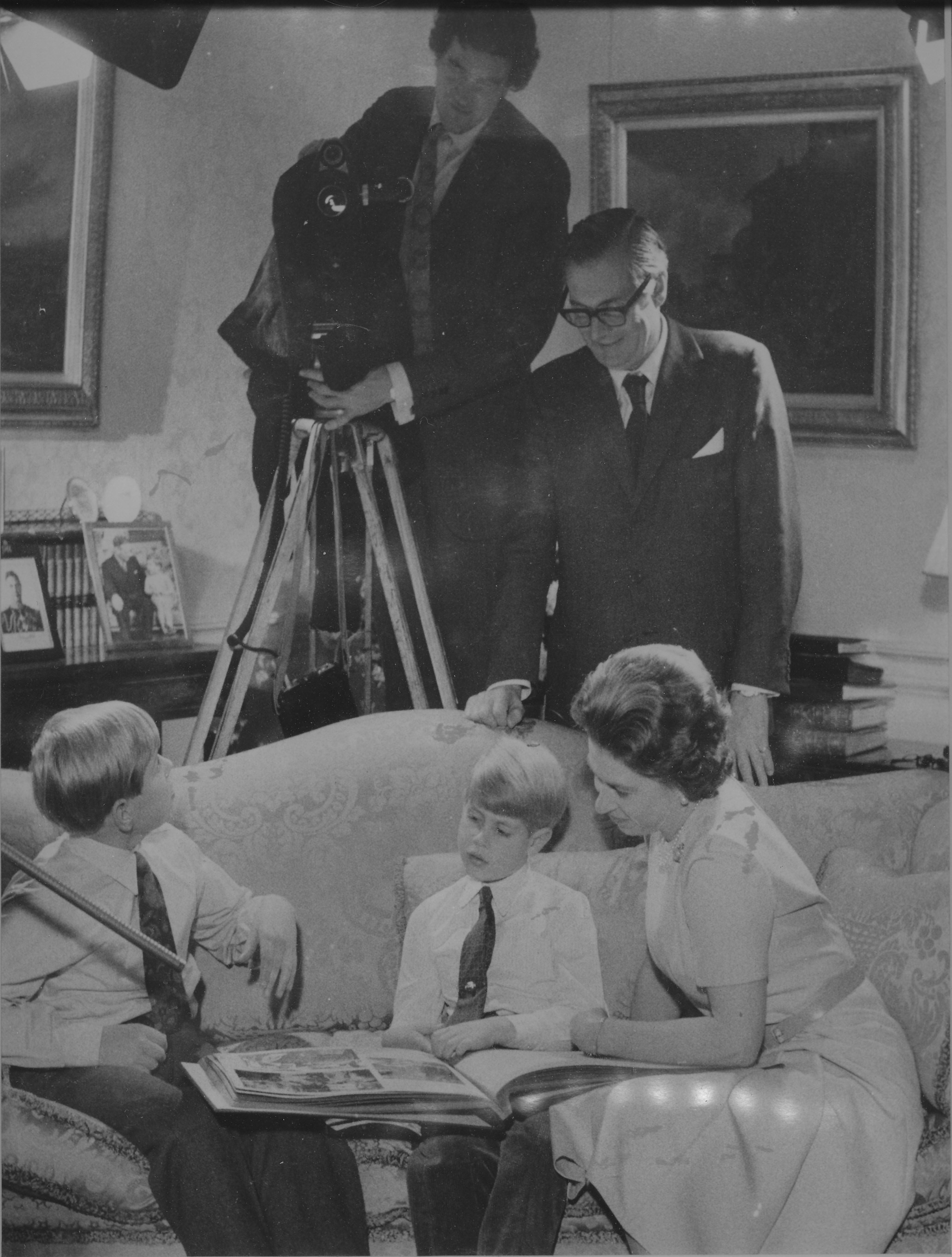
Ray and director, with Her Majesty Queen Elizabeth II with Prince Andrew and his brother Edward 1971. This Christmas Message is available in the YouTube video:
What came next?
I was looking forward to shooting some drama and had the opportunity to film THE SNOWGOOSE which was a great experience. This was a 1971 production, the same year I got married.
It was based on the Paul Gallico novella, The Snow Goose: A Story of Dunkirk. It was originally scheduled to be filmed by ITV. There was a cocktail party prior to shoot; those present were the American producers from Universal Studios it being the first co production with Universal.
Robin Scott was then the head of BBC 2 and was there to observe. He overheard a conversation between the producers and the ITV rep. When that had all broken up he quietly went over to the producer and said that the BBC would like to handle the production saying we could do it with a smaller budget that ITV had quoted. They had another meeting the next day when Robin secured the rights.
Universal demanded a well known actor like Richard Burton or Paul Newman or Steve McQueen. Robin did his research and found all the big stars at the time were committed to other projects ….. apart from Richard Harris. Now Richard is an Irishman who liked a drink or two and would get into fights that made sticking to a filming schedule difficult. A very good actor but unreliable. Universal agreed stating in his contract that he mustn’t leave the area in which we were filming – which was out of London and should eliminate much of his/their problems.
We were filming on the East coast at a town called Frinton – it was to be a four to five week shoot. The first week we shot interiors and all went well – young Jenny Agutter was the young actress who had just come back from filming WALKABOUT in Australia. She was perfect for the role.
After a successful first week of shooting, the call time was 0700 for the Monday. Monday morning arrived; ‘Have you seen Harris? he’s supposed to be here – wasn’t it a 7am call?’ – I said ‘well yes, but that’s Harris, we did try to tell you.’
Finally at 10am Richard rolls in, he had two black eyes and is walking with a limp and his hairdresser had dyed his hair. The Director Patrick Garland and I looked at each other …….. what to do? We’ve already filmed some interiors – makeup – can you fix his hair, and face?’ I explained ‘we can’t do close-ups looking like that ‘– if we filter the colour of his hair it means everything else will change…’
We hastily re arranged the schedule concentrating on exteriors – with English weather you always have to plan weather cover. We had built the lighthouse and were shooting 35mm as were Universal’s requirements using two cameras for 50% of the shoot.
I was invited over to Hollywood with the Director to meet Universal executives and watch the first preview. It was nominated for a number of awards including cinematography. We were ushered into the theatre where Technicolour was based – they wanted to see how well English Technicolor was performing.
Frank O’Connor was with us in the front row. It’s quite an emotional film, especially at the end when the goose flies off. We could hear sounds of suppressed tears and handkerchiefs were out!
Frank turned to us and said ‘we’ve got ‘em, they cry at nothing!’
It won a Golden Globe Award for Best Television Film and was nominated for a British Academy Television Award for Best Drama Production. It was also nominated for a nine Primetime Emmy Awards, winning one for Jenny Agutter for Outstanding Performance by an Actress in a Supporting Role in a Drama.
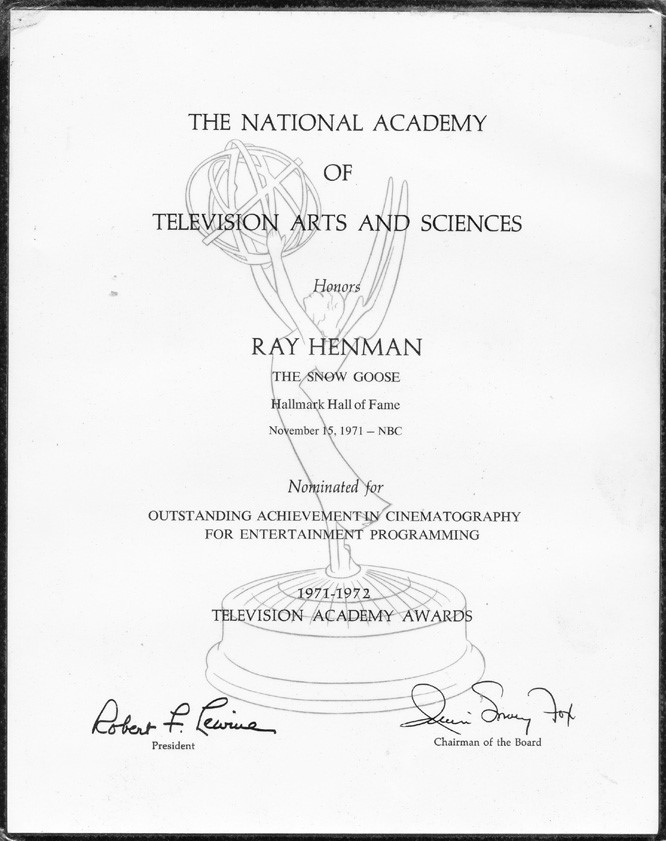
Ray was also nominated - for an Emmy!
The last story from that era – a documentary in Alaska called ‘THE DAY THEY SOLD ALASKA’. This was when the big oil companies bought up the oil leases on the northern slopes. We were based at Point Barrow. The Director, who’d arrived before us, had arranged a bubble Bell helicopter to take us up to the Brooke Ranges where the tribal Eskimos lived, tells us 'it’s about an hour’s flight and you have got to be back on the ground here before 3pm, at 3 o’clock the afternoon mist comes in and visibility is severely reduced'.
As the cameraman you should check out the aircraft and the pilot where possible. This pilot had come back from serving in Vietnam and was still a bit gung-ho. He walked with a limp and had a twitching eye, I was a little apprehensive.
I was sitting alongside him on his left and the sound recordist was in the back. We took off on a bright clear day. It took us less than an hour to get there then spent an hour on the ground.
On the way back the pilot said, ‘we won’t go straight back to base – I like flying over where all these beautiful animals; there’s antelope, brown bears, polar bears and caribou.’ I said that’s nice but only if it’s enroute, we must be back at base by 3pm.
We flew over a mountain area with a lot of brown bears nursing their cubs, as we swooped down on them they weren’t happy, but he kept buzzing them.
It’s now 2 pm and you could see the white mist starting to roll in. Five minutes later the pilot looked concerned – ‘we should be close to base ….this damn radio is not responding’ !
I noticed the fuel gauges were nearing the red zone, minutes later they started to flash….. out of fuel at about 500 ft and down we went. The helicopter’s main rotor can ‘back pedal’ which slows you down, we landed with a hell of a thud but we were intact. We had landed in the middle of a river, on a centre sandbank.
The bears were still angry and had been following us and were only 50 metres away, fortunately they wouldn’t go into the water.
The pilot got out, drew a shotgun out and waded into the water which was waist deep; ‘where are you going?’ - he said he was off to find somebody !! The temperature then dropped sharply as the mist enshrouded us
John, the Sound Recordist who was sitting in the back gave the radio a thump, a dry joint was the problem, he managed to send out a distress call.
Half an hour later we could hear but not see a DC3 circling, the mist had totally engulfed us by then.Moments later another helicopter approached and lowered a 44 gallon drum along side us. The pilot heard this and returned, he pumped enough fuel over to get us back to base which was only 5 minutes away.
That night we ate caribou and drank a lot of beer watching the northern lights. That military base is called DEAD HORSE !

a similar chopper near Point Barrow
You went into Feature Films after leaving the BBC?
Yes, in Australia. I shot five low budget movies. “LADY STAY DEAD” was shot at Palm Beach and surrounds. Available at: https://www.youtube.com/watch?v=dRkuv75yuDs (NB Parents: Age restriction)
Sunrise Road never knew what hit them.
Documentaries with Don Featherstone Productions was enjoyable. These were featuring Arthur Boyd, Peter Carey, David Williamson, James Morrison and Tom Keneally. The documentary in war torn Eritrea with Tom was fraught with danger. Filming in a trench on the front line with 25 dead bodies was ‘memorable’.
June says you’re both interested in local history?
Yes, we’ve been busy making a video on the Centenary of Avalon Beach featuring members of the A J Small family whose grand father was responsible for the 1921 land release.
What is your favourite camera ?
In those years my choice was the 16mm Éclair because it sat on your shoulder, the Eclair NPR was used on the ROYAL FAMILY documentary.
The Sony Betacam arrived in 1984, which was one of the first alternatives to film.
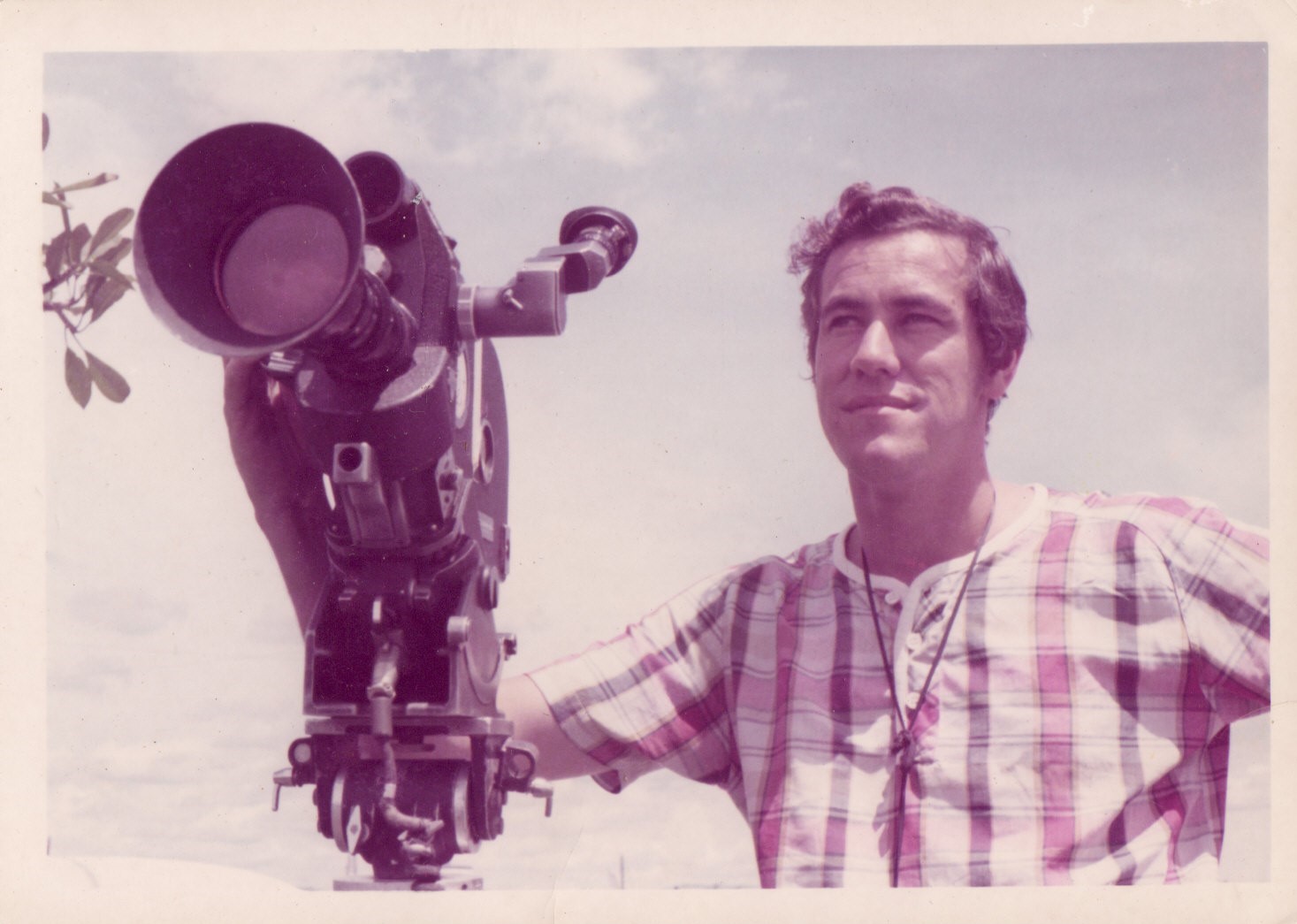
Ray with an Eclair camera
What would you say to anyone who wants to get into filmmaking – how can they pursue that?
I have been asked that by a number of young people over the years. My advice to them is to go into the websites, find out which movies and commercials are being shot. Talk to the production manager and if accepted spend your time with the lighting gaffer, they won’t pay you but they will feed you, at the same time check out the The Film and TV School.
Ray, you have seen a few changes between the Palm Beach of your youth and today – what are the starkest changes?
The increase in population and the prices, particularly in the last couple of years. When that house in Iluka Road recently went for 27 million dollars just around the corner that just stopped everybody in their tracks. Avalon, now an agents paradise !
Local commercial fishing has virtually dried up, the daily crayfish catch has long since gone, spear fisherman saw to that. As a kid I used to go out with the fishing parties just down from where we used to live. There were two boats and the Gonsalves and the Gows and the Goddards – the Caroline H and the Mary Jane. I used to go out fishing on them quite a lot, we were catching red snapper.
I also used to go out with an old fisherman who fished for prawns and crayfish. We’d go to the back of Lion Island, put a dozen crayfish pots down there and then out the back of Palm Beach and Whale Beach, off those headlands – and they would be full of crays every morning. You’d throw back the females and the little ones and still have a heap of them.
Then spear fishing came along; they allowed that to happen, and that’s what killed off all the life along those rock shelves. They were plentiful prior to that.
The fish we caught were larger too, and more plentiful – lots of big flathead – and large snapper, up to six pounds or more – and they take a long time to reach that size, and those are a bit further out too.
The fish used to come in and be weighed down on the old public wharf at Palm Beach, they had scales up there. One of the captains of the boats was very badly injured. Doctor Joan Beatty came down and actually did everything on the wharf itself. She had a practice in Avalon, above the French restaurant on Avalon Parade. She drove a Triumph Stag that dad used to service.
The ferries have changed too – there was the Swanhilda, the Rambler, the Currawong, West Head and the Brooklyn ferry. Heritage houses are being knocked down everywhere too, which is a shame.
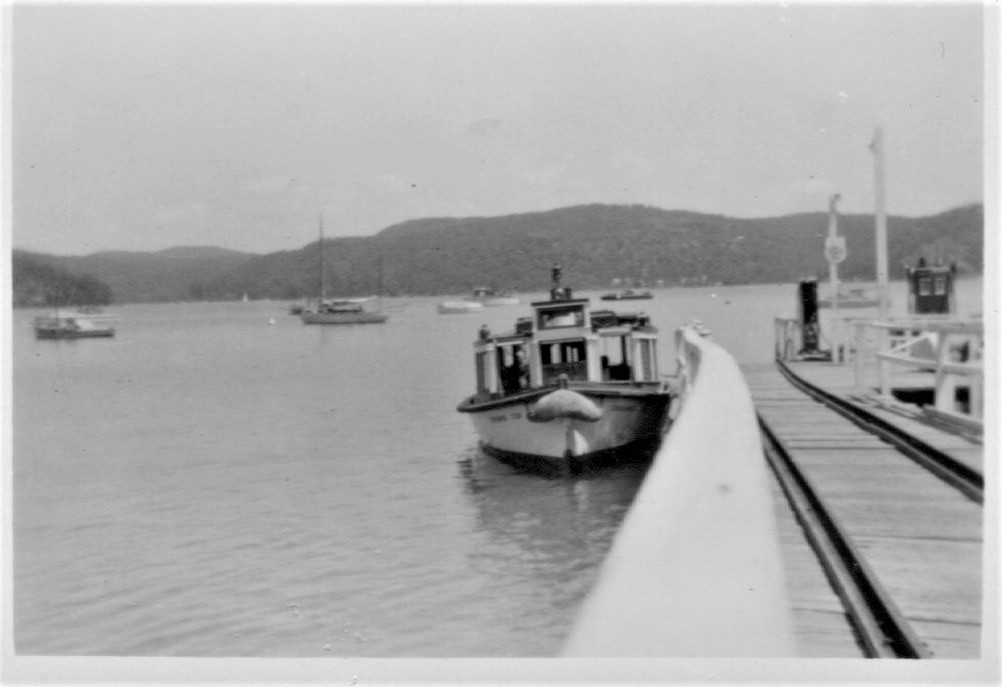
Ferry at a Palm Beach wharf
What are your favourite places in Pittwater and why?
It’s hard to pinpoint a particular spot, I love the whole location, the area between Lion Island, West Head and the Barrenjoey headland remains a favourite.
So has your son gone into film as well?
He works for ROCKSTAR Games in New York, it’s the world’s largest games company.
At the age of 12 at Mona Vale Primary School he was given a project to work on, he chose the ‘’THE HISTORY of PALM BEACH and AVALON”, he directed and I shot it.
What is your 'motto for life' or a favourite phrase you try to live by?
I keep one eye on the future. As the years roll on, health remains your primary asset ……… look after it. !
Visit: www.rayhenman.com
Notes
 CHUCK IS AUSTRALIA'S MR. TV
CHUCK IS AUSTRALIA'S MR. TV
To the thousands of viewers who tune into TCN-9 in the early evening for the latest news. Chuck Faulkner is as familiar as the family next door. Chuck has been reading the news on TCN since the station opened more than four years ago.
But not many of the thousands of viewers know the struggle Chuck had to make the top. Born Charles Stephen Faulkner in Belfast, Ireland, on October 21, 1922, Chuck came to Australia with his parents in 1927. He was educated at Newcastle Public School and Cleveland Street High, Sydney. At the age of 15, Chuck became an apprentice jockey— at 7 stone 8 lbs., he was ideally weighted for the job. After 18 months, he joined the A.I.F., and served in the Middle East and the Pacific Islands. As a sergeant, he worked as a producer and actor in A.I.F. concert parties during the final 12 months of the war.
Discharged in 1945, Chuck tried to break into Australian radio, but had no success. He joined the N.S.W. Police Force, and was stationed at Darlinghurst for 18 months.
Went to US.
In 1947, Chuck went to the United States to try and break into the entertainment field. He worked in radio and television in Ohio, West Virginia, Pennsylvania and Wisconsin, and became well known as a disc jockey, news reader and actor. He returned to Australia in 1954 with an Australian wife, Essie, and two children, Bonnie and Debbie, both born in America. He did radio announcing at 3AW Melbourne and 2KO Newcastle for two years.
Chuck joined Channel 9 TCN in July, 1956, and made the first Australian news and weathercast an September 16, 1956. He is the only Australian TV star to have made nearly 2000 live appearances. He was voted 'Mr. TV in 1958, and has 'always been included among the top three Australian stars.
Compere and M.C.
Besides his news and weather, and Tic Tae Dough, he has compered numerous quiz shows, has done sporting events children's programmes, and is well known as a master of ceremonies. He has also guest, starred in two episodes of the forthcoming Australian made TV series, 'WHIP-LASR'
Chuck's hobbies are horse racing (he owns Black Satin, a four-year-old filly), and golf -he's a member of the Beverley Park Golf Club, with a handicap of 17). His ambition is to produce and star in his own television show. CHUCK IS AUSTRALIA'S MR. TV (1960, November 16). The Biz (Fairfield, NSW : 1928 - 1972), p. 15. Retrieved, from http://nla.gov.au/nla.news-article190739458
Chuck Faulkner was an actor and writer, known for Division 4 (1969), A Cry in the Dark (1988) and Homicide (1964). He was married to Julie Faulkner and Essie Faulkner. He died on December 4, 2000 in Virginia Beach, Virginia, USA.
Kenneth George Hall biography available at: https://adb.anu.edu.au/biography/hall-kenneth-george-ken-27403 In 1956, Mr. Hall became general manager and then Chief Executive for Channel Nine in Sydney, where he remained until 1966. There he instigated the practice of showing feature films uncut.
The Plaza Theatre
Located on an excellent site in Lower Regent Street, just south of Piccadilly Circus, the Plaza Theatre was built for and operated by Paramount Pictures Inc. It was designed by Frank T. Verity with plasterwork by Marc Henri, and opened on 1st March 1926, with Dorothy Gish in “Nell Gwyn”. It was sumptuously decorated with total seating for 1,896 divided between stalls, Royal circle (mezzanine) and balcony. There was a small stage and live acts were a feature of the programme - including the famous Plaza Tiller Girls. It was equipped with a Wurlitzer 3Manual/15Ranks theatre organ (with piano attachment), and had a cafe.
The Plaza Theatre lasted without alteration until 27th September 1967 when it closed with Craig Stevens in “Gunn”. The lovely Italian Renaissance style auditorium was gutted to form two cinemas, designed by Samuel Beverly of architectural firm Verity & Beverley with David Hicks as colour consultant to reflect the tones and conditions of the 1960’s. The Wurlitzer organ was removed and sold to Leonard Bartholomew. The 820-seat upper cinema was used as an extended balcony and the original projection box, retaining the name Plaza. The stalls, which extended into the stage area, became the 972-seat Paramount. They re-opened 28th July 1968.
The Paramount used a new projection box constructed in the former Royal Circle area. The Plaza was renamed Universal from 25th May 1972, but old names linger and from 15th May 1975 they were both renamed Plaza 1 & 2.
Sir David Frederick Attenborough (born 8 May 1926) is an English broadcaster, biologist, natural historian and author. He is best known for writing and presenting, in conjunction with the BBC Natural History Unit, the nine natural history documentary series forming the Life collection, a comprehensive survey of animal and plant life on Earth.
Susanne Wenger
Chief Susanne Wenger MFR, also known as Adunni Olorisha (c. 1915 – January 12 2009), was an Austrian-Nigerian artist, illustrator and comics artist, who resided in Nigeria. Her main focus was the Yoruba culture and she was successful in building an artist cooperative in Osogbo. She partnered with local artists in Osogbo to redevelop and redecorate the Osun Osogbo Sacred Grove with sculptures and carvings depicting the various activities of the Orishas. Chief Wenger lived in a three-storey residence in Osgobo originally leased by her first husband Chief Ulli Beier when he was with the Institute of Mural Studies. In 1965, she shared the building with her second husband, the drummer Lasisi: both lived on the first floor while her previous husband Beier lived on the second floor. She continued with the lease after Beier left in 1970, and remained in the house following her divorce from Lasisi. Her residence showcases her art, as many of the house's furniture depicts an aspect of the Yoruba art form that Chief Wenger loved so much. Wenger was a leading advocate for the preservation of the Osun Grove. Due to her efforts, the grove was made a national monument in 1965, and was later inscribed as a world heritage site.